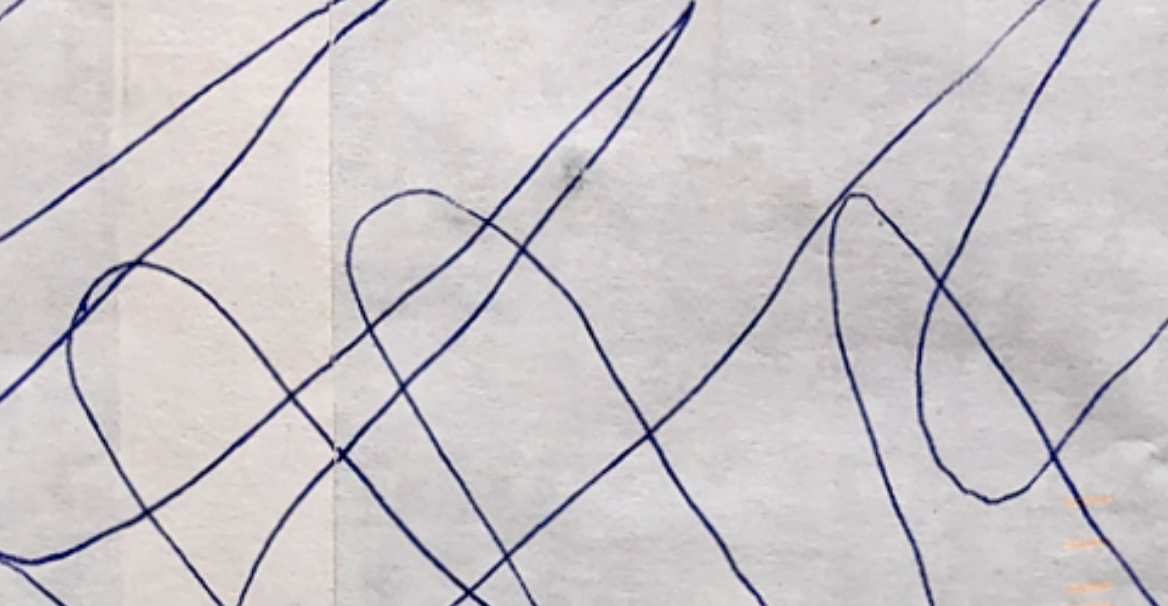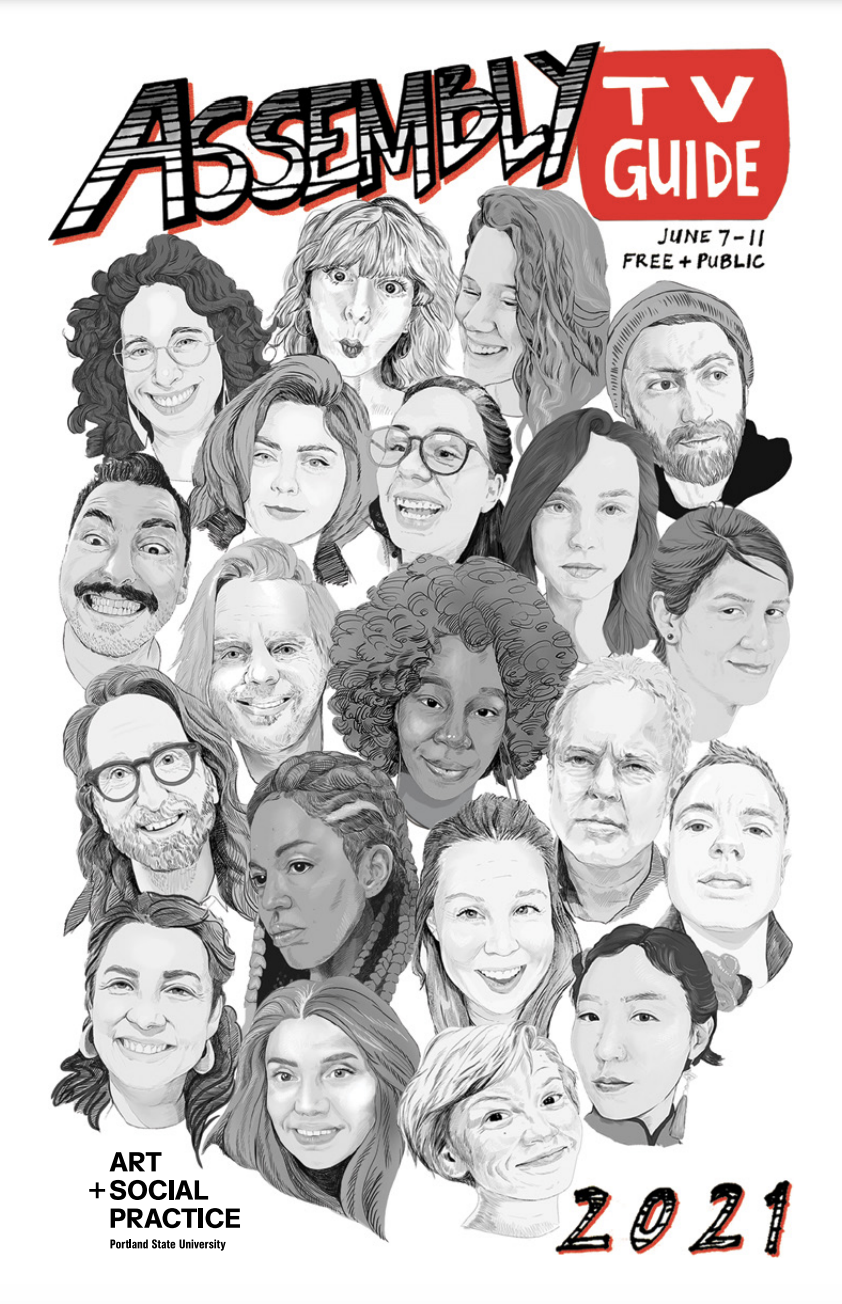5th Grade Safety Patrol High-Vizibility Crosswalk Spectacular
2022A Pedestrian Parade that appeared in Portland State University’s Assembly 2022 conference at Martin Luther King Jr. School in Portland, Oregon
Made in collaboration with Becca Kauffman and the Dr. Martin Luther King Jr. School Safety Patrol team. Textile materials and reflective vinyl donated by Niek Pulles and the Nike materials lab.
The luminescent hues of safety orange, neon yellow, and retroreflective silver create the palette for hi-visibility workwear, a standardized form of safety apparel designated for construction workers, flaggers, and any job performed in or near oncoming traffic. In this project, we teamed up with the Dr. MLK Jr. School 5th grade Safety Patrol, a group of 14 junior crossing guards, to design their own custom uniforms using the hi-viz color scheme and visual symbology of street signs. The new line of Safety Patrol vests and handprint flags debuted at a participatory pedestrian parade and celebration of visibility at the school’s newly painted crosswalk.
Previously, the school rotated 4 vests among the group of 14 safety patrollers, and in this we saw a need for individual uniforms. During workshops in preparation for the parade, we discussed the imagery of traffic guidance and the significance of communicating with others for greater public safety. We worked with each of the students to design “dream vests” which then were distilled into our found and donated materials that represented the hi-vis family of neon orange, yellow, black, and reflective traffic-glam.
The parade was accompanied by a soundtrack mixed by DJ Sappho, and concluded with the premiere of Wake Up, an original track created by Jagz — elementary school students in the King School Museum of Contemporary Art (KSMoCA) mentorship program. Production of the track was led by the student’s mentor, Lyberty Udochu.




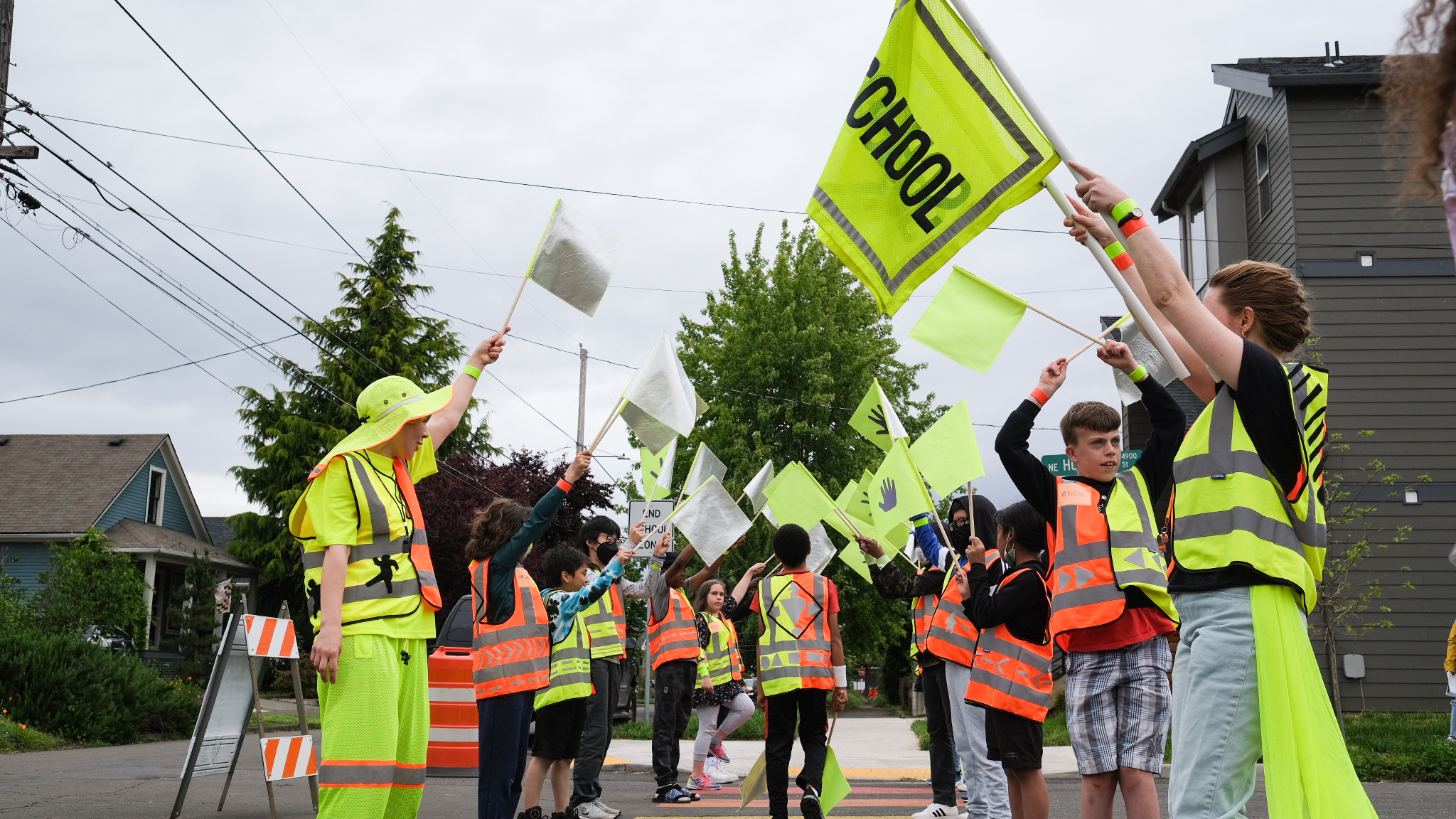

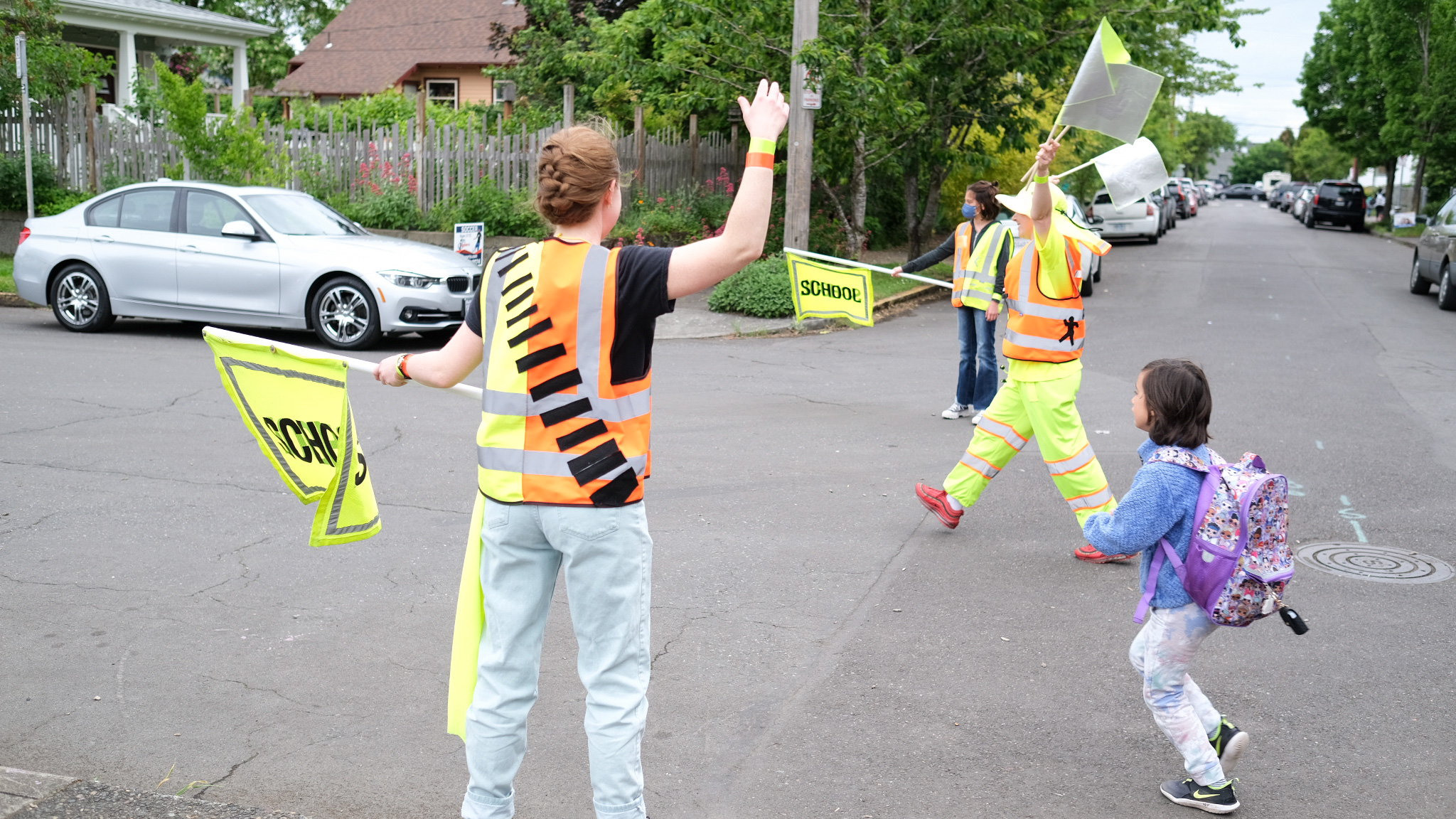



Continued Vizibility
In our workshops with the students, we brought attention to vizibility as an empowering act for the body in public. While wearing hi-vis, a person is at once individual and a part of a collective; protected by visual conformity. These vests use that concept and subvert it by becoming personalized garments that still perform their primary alert function. The uniforms will be used by future generations of Dr. MLK School Safety Patrollers to come, and they are functional fashion — acting as teaching tools for the value of communication in public space.
One Day of Seeds
2022Sculptural documentation of labor performed for one day in Oregon’s Willamette Valley.
Made with Shannon Welsh and Dr. Jennifer Kling
This temporary documentary sculpture is a map, and it reflects a diagram made by seed breeder Dr. Jennifer “Jenny” Kling, who is developing a flax crop for large-scale linen production. She does this work in collaboration with Shannon Welsh, a textile designer and sustainable fiber advocate, and Angela Wartes-Kahl, a farmer and organic certification specialist.
On October 18th, 2021, I accompanied Shannon Welsh and Dr. Jennifer Kling to plant seeds in their Alpine, Oregon field trial. Neal, Elizabeth, and Gary joined us that day to prepare the soil and plant dozens of types of seeds in 2’ x 3’ test plots. After that day, I kept all of the leftover labeled seed envelopes to use as a device for storytelling — laying them out in a grid as they were planted in the field. I am interested in this narrative because it connects work, time, and place using a simple visual method to describe a complex and largely social process. I’m also viewing seed breeding conceptually as one example of many natural processes influenced by people’s hands for worldwide material consumption. It physically demonstrates cooperation between people, our built environment, and our organic environment.
An interview with Jenny about the process of seed breeding and crop development was published in SoFA Journal’s Conversations on Everything to accompany the exhibition.
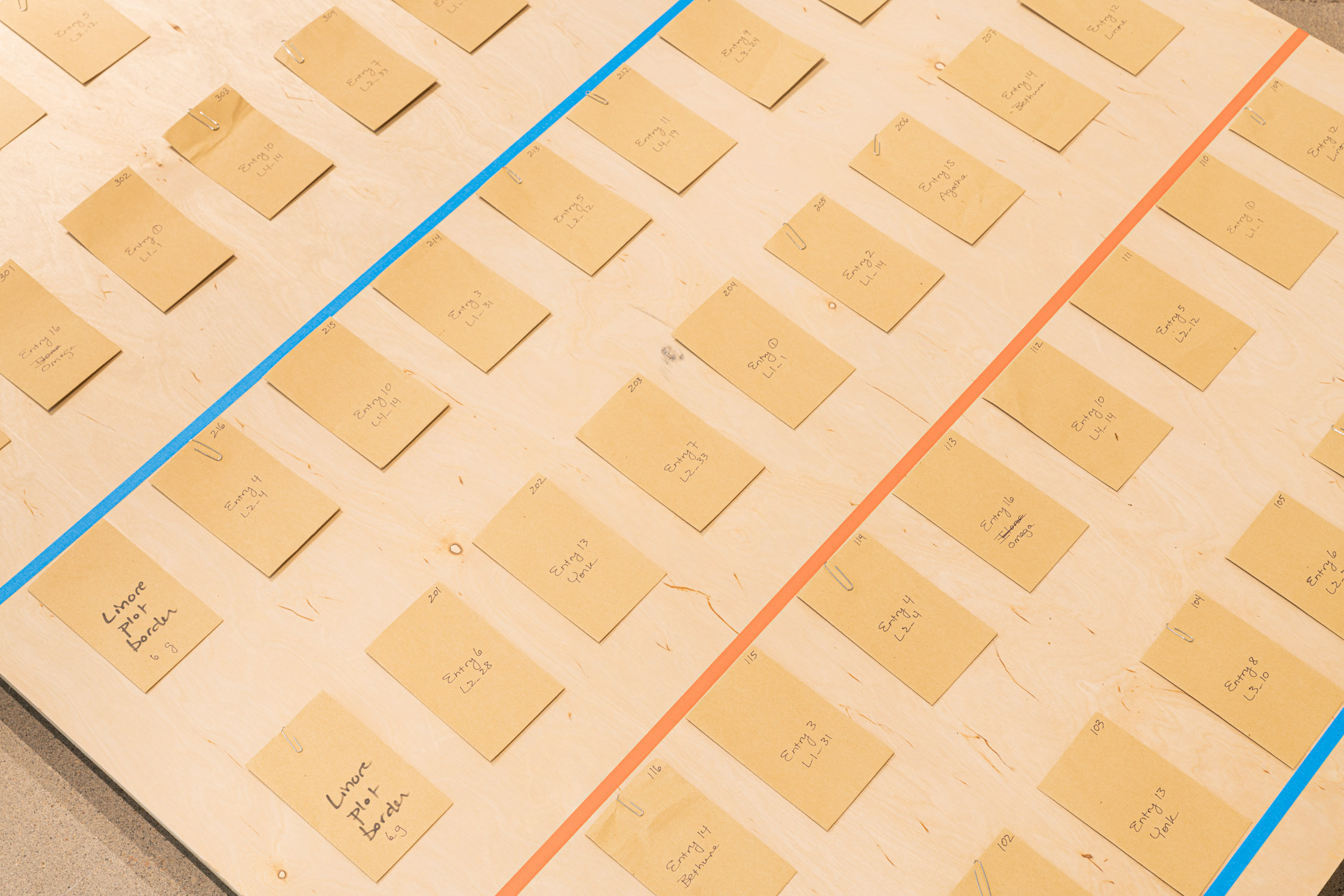
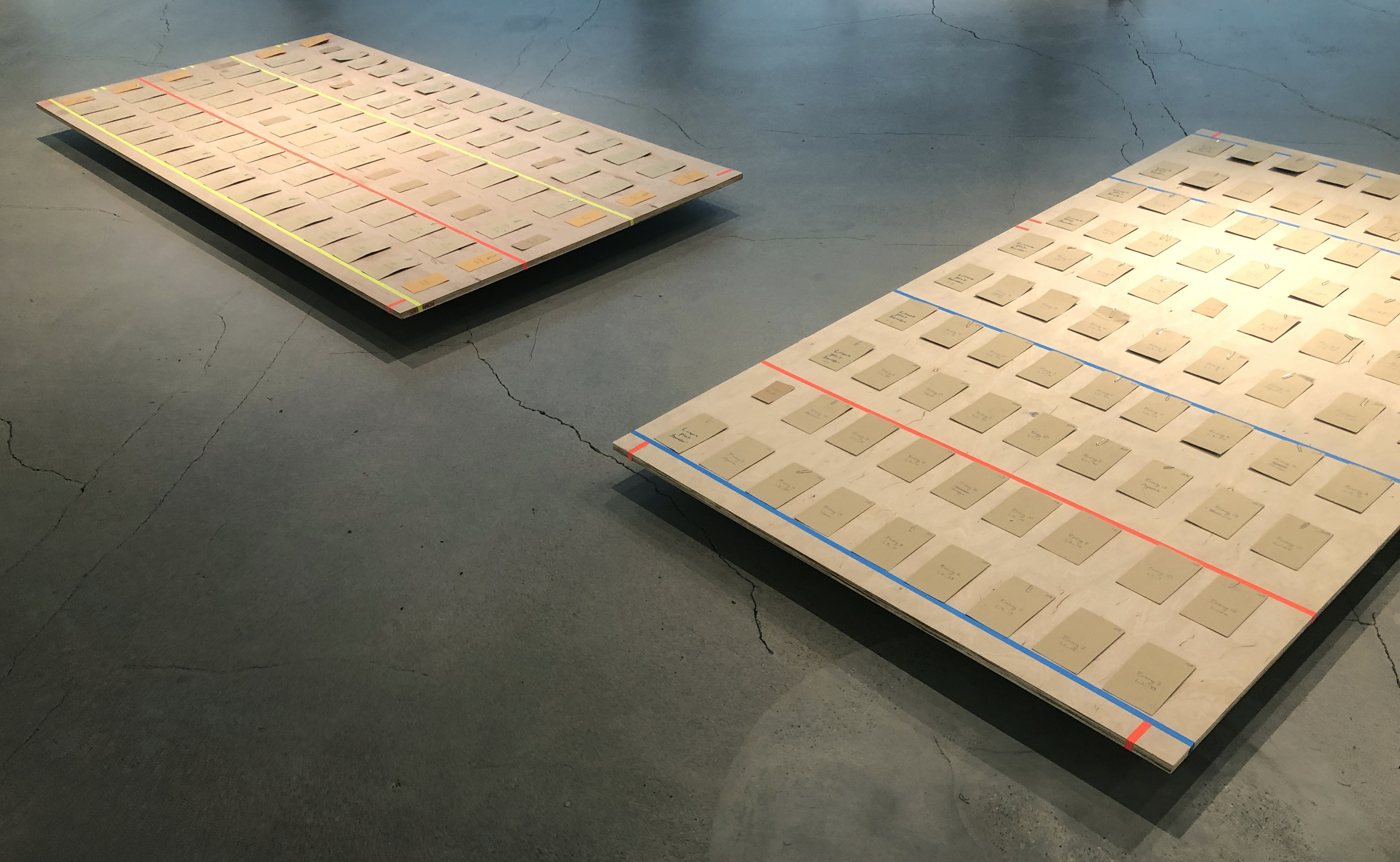
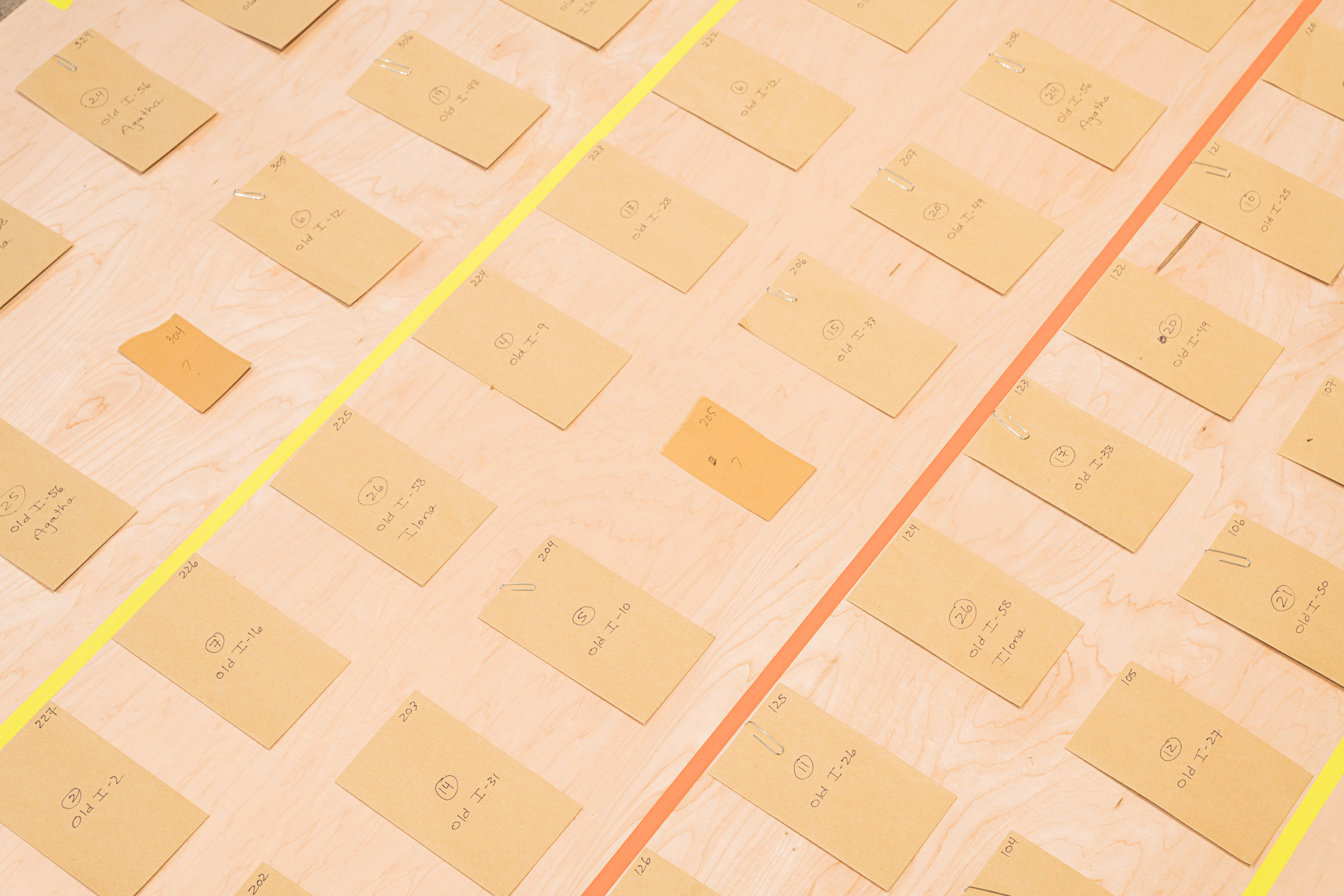
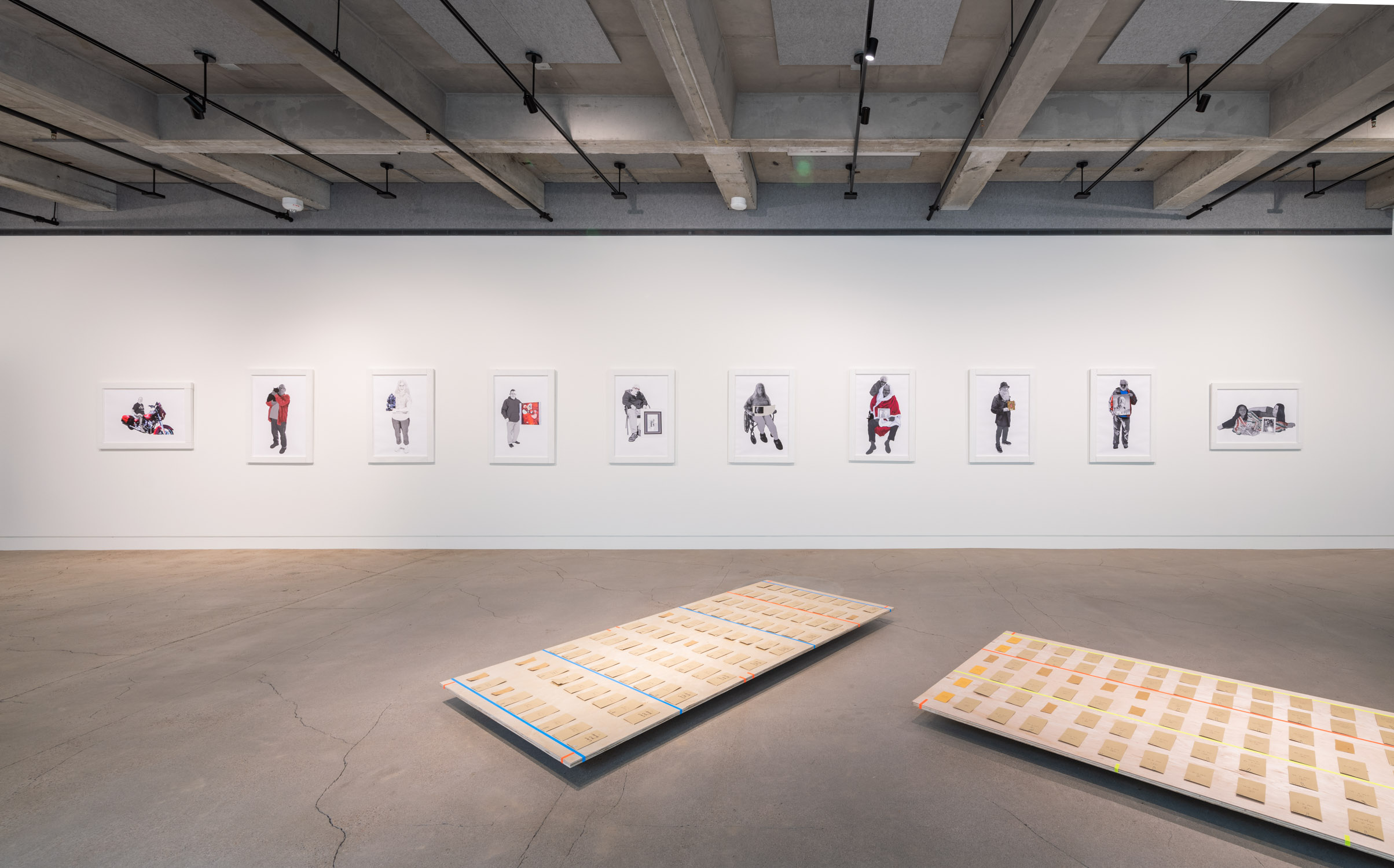
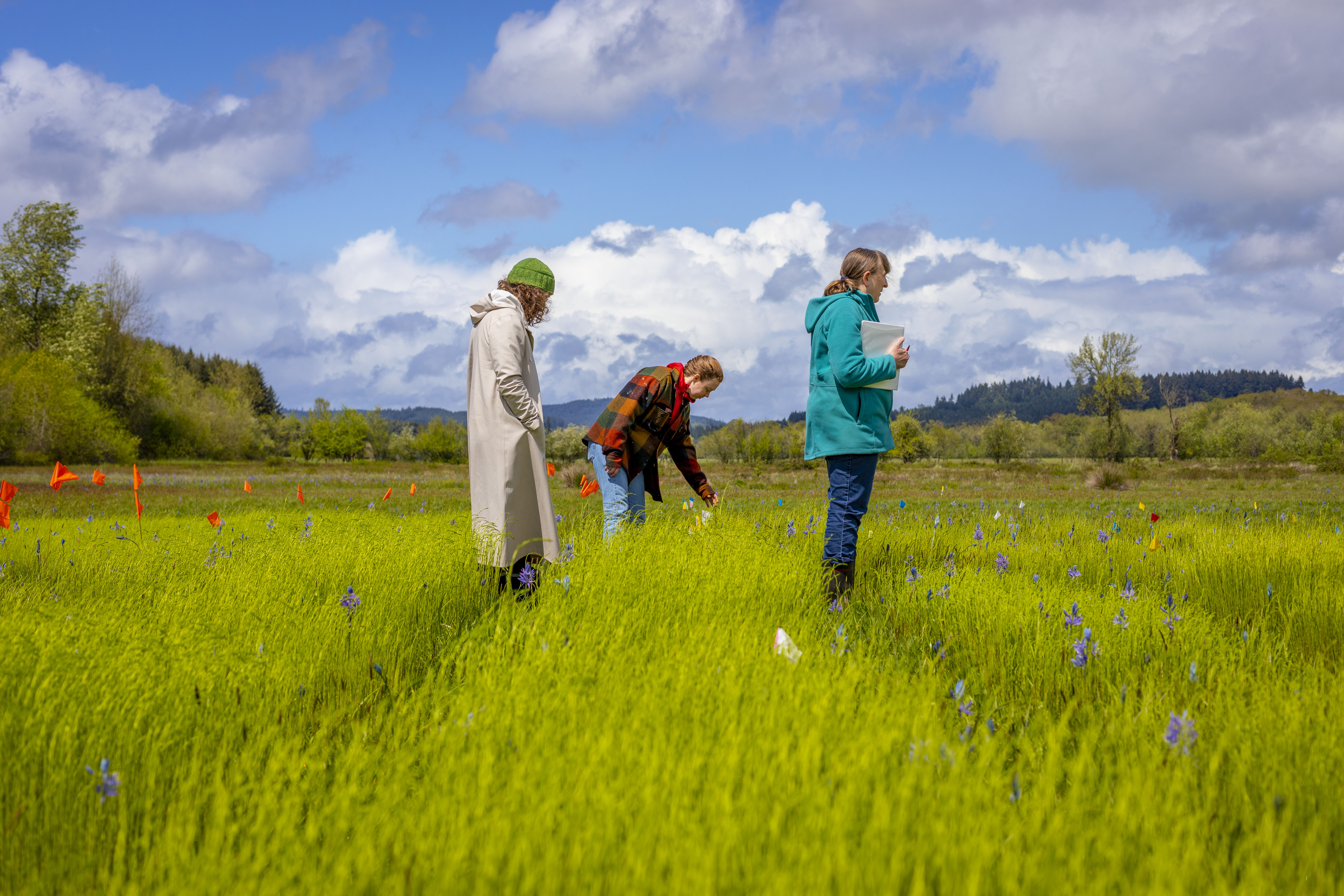
Context:
The Willamette Valley was a significant producer of flax for linen until domestic flax was threatened and ultimately overpowered by cotton and plastics in the early part of the 20th century. Linen now represents a sustainable alternative to many widespread garment textiles.
During the process of planting seeds together that day, I learned about the research, labor, and experiementation that go into reviving an agricultural crop in a rapidly changing climate. This sculptural map is a momentary pause in the 7 to 10 years that go into developing a crop, starting with a single seed.
In the Wall
2022Hidden capsule made with a group of woman-identified architectural restoration technicians.
Made in collaboration with Rachael Boles, Sharneé Burnett, Emily Eliot, Bethany Endicott Gill, Terri Hoffman, Jacintha Kruc, and Megan Webb
Something is hidden behind a wall of the Governor’s Suite at the Pennsylvania State Capitol. Like a time capsule, this plastic bag contains objects, but the items contained here don’t share much about the day, time, year, or the building itself. This collection is more for the imagination, and it will tell you about eight of the people who worked in the space for about 10 months of restoration efforts: the first time the office has been under construction since the building’s opening in 1906. Unlike a time capsule, this series of objects may never be opened or found by someone excavating the walls at some unknown later time.
But, it’s sort of a game, poking fun at (and also interrogating) a circumstance that occupied many conversations over the course of the wood refinishing process: a team of eight woman-identified restoration technicians were uncovering and revitalizing symbols of mythical feminine bodies and ripe floral scrollwork in a predominantly male seat of power, doing a type of work that remains stubbornly male-dominated.
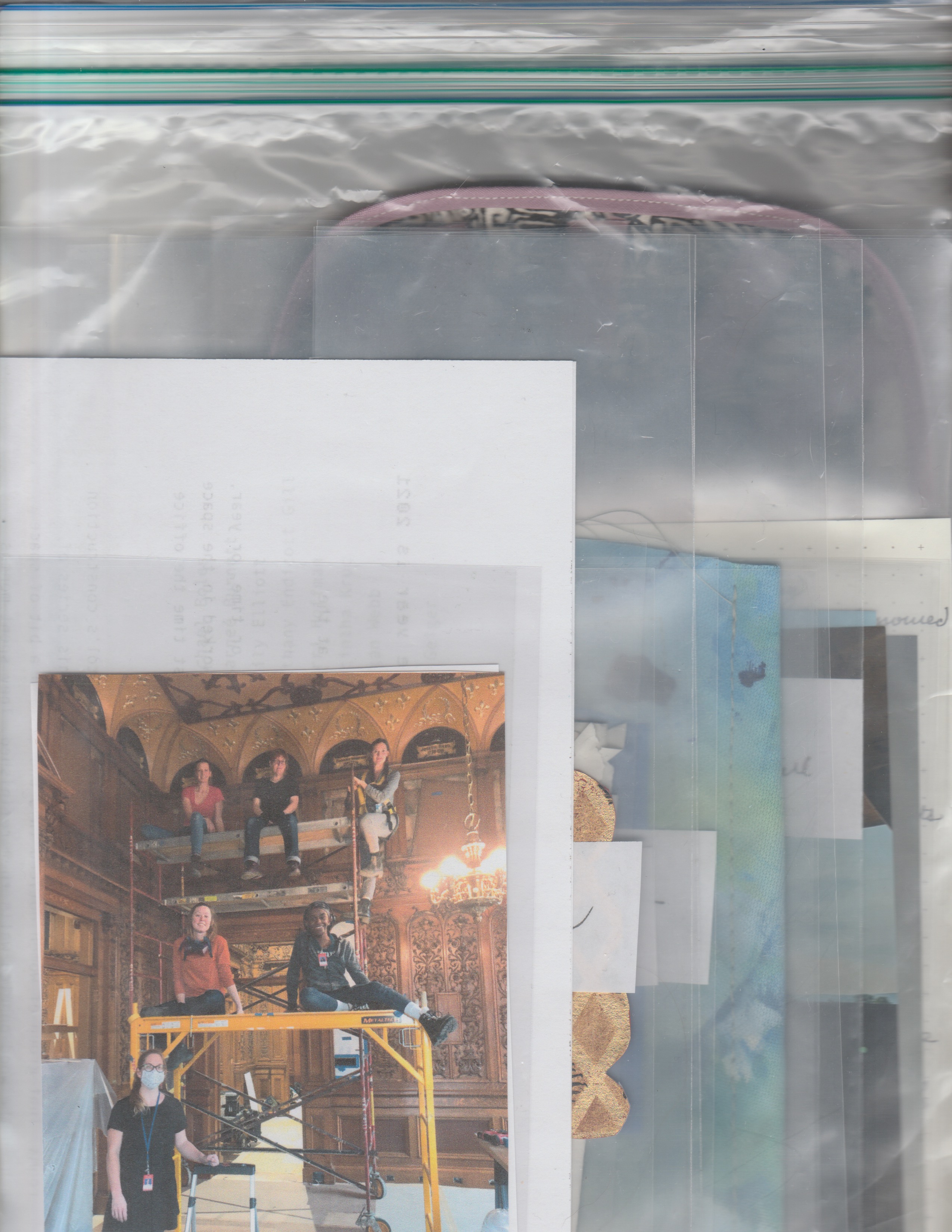

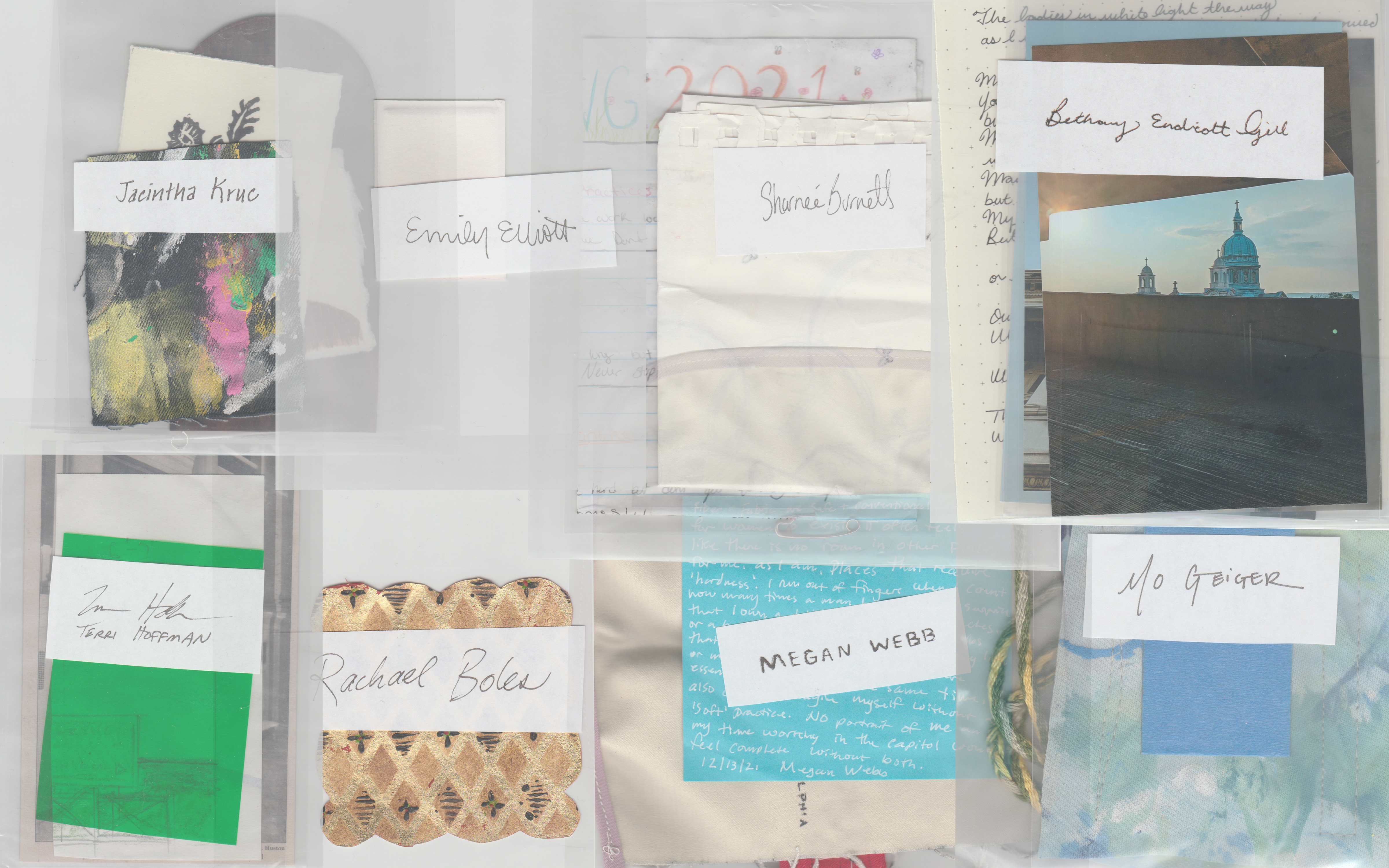
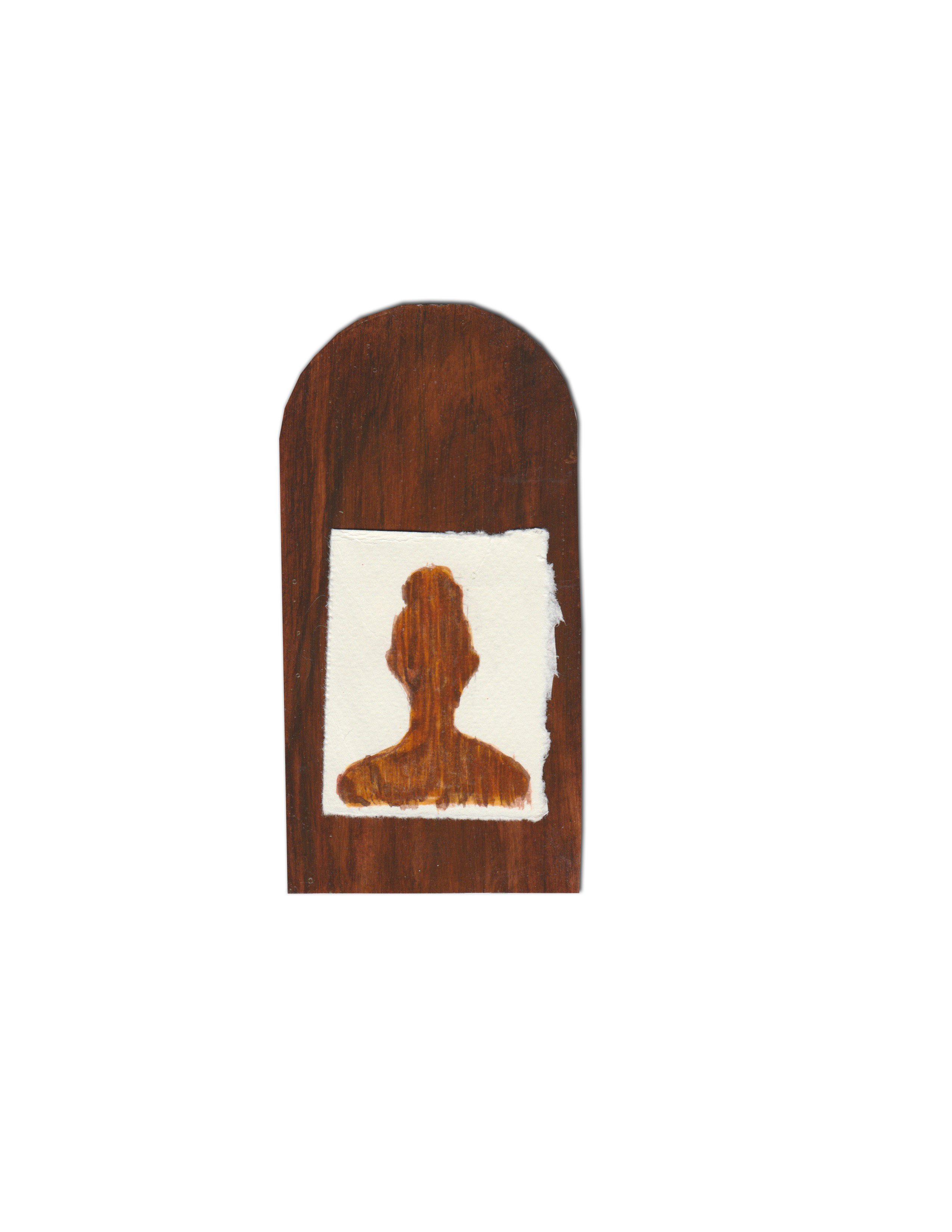
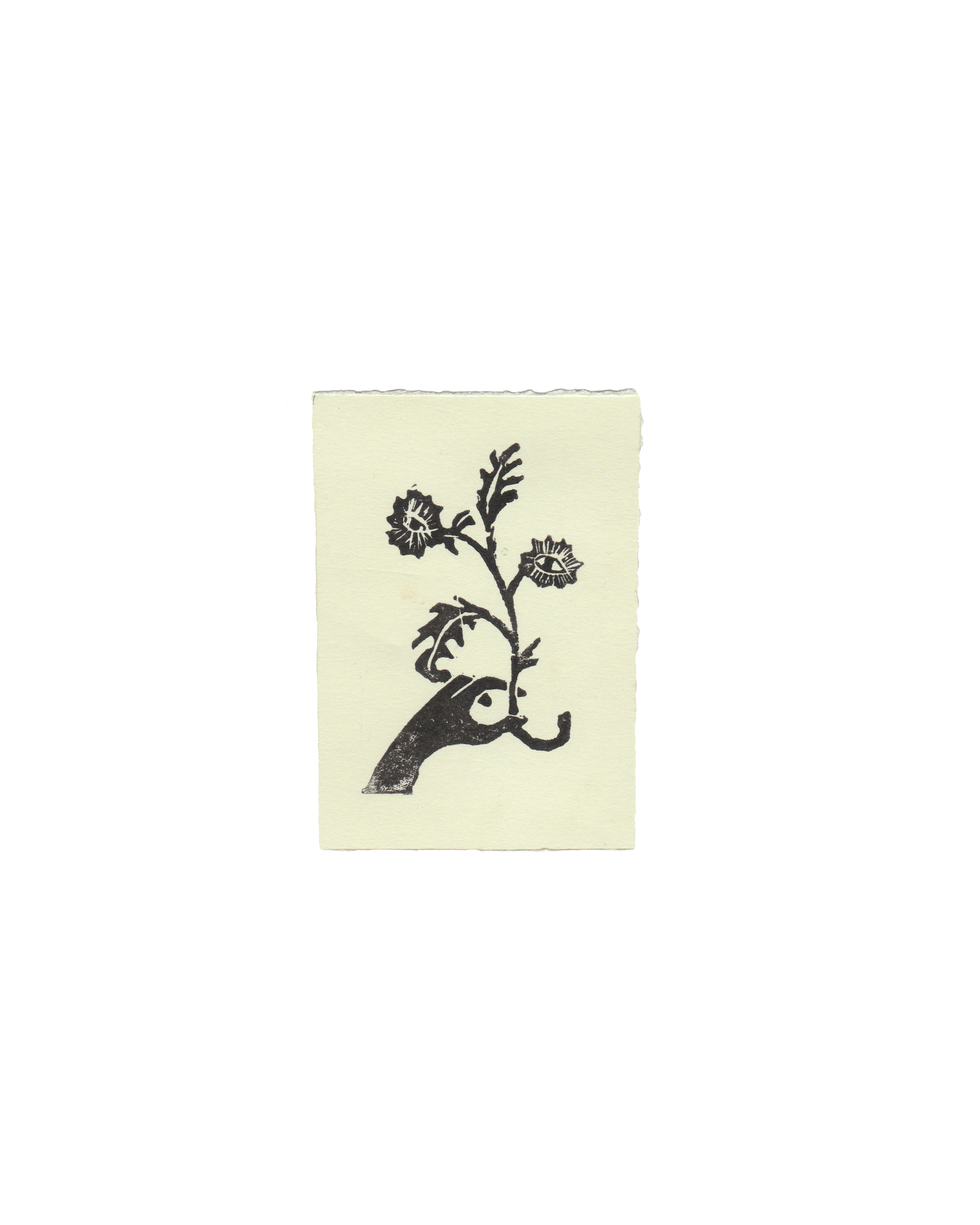
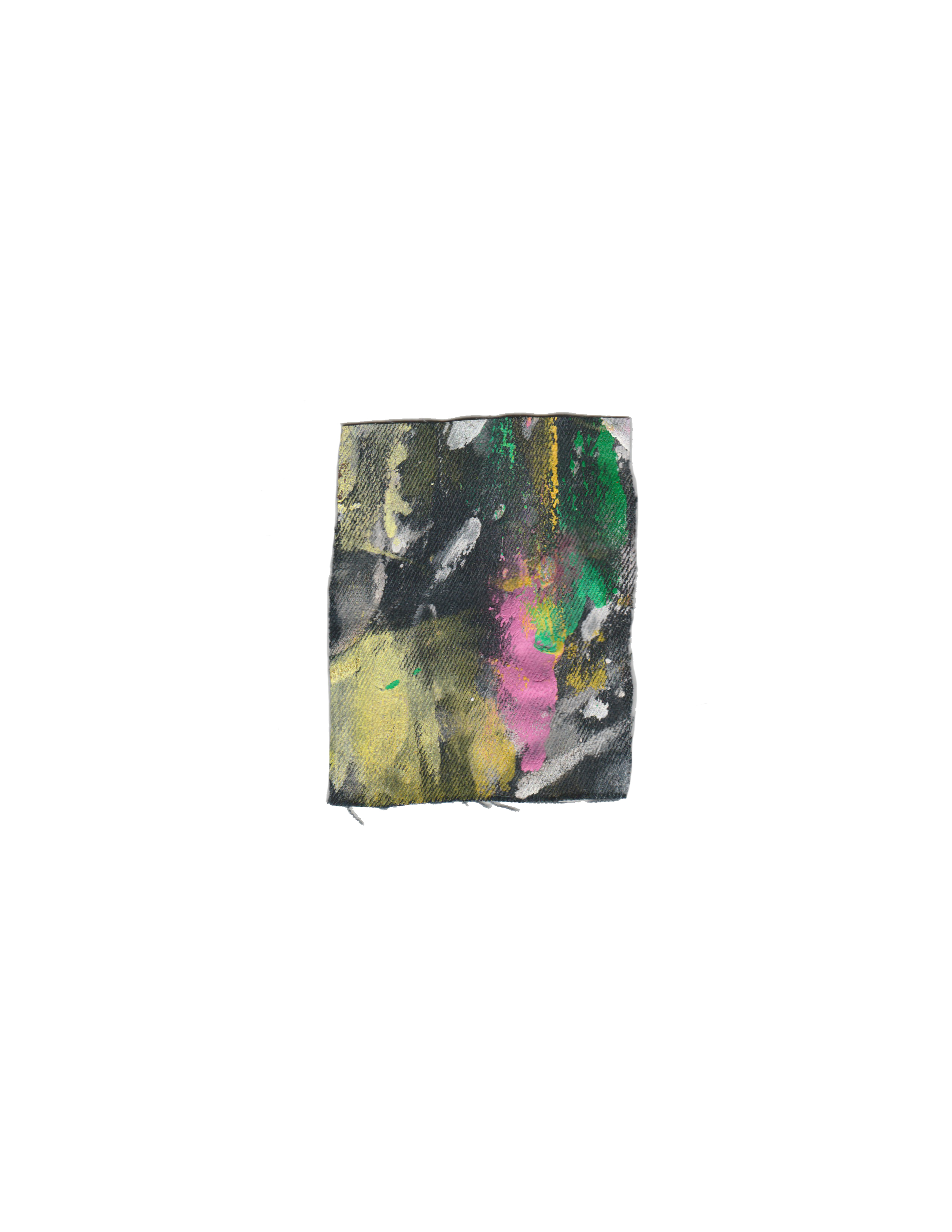
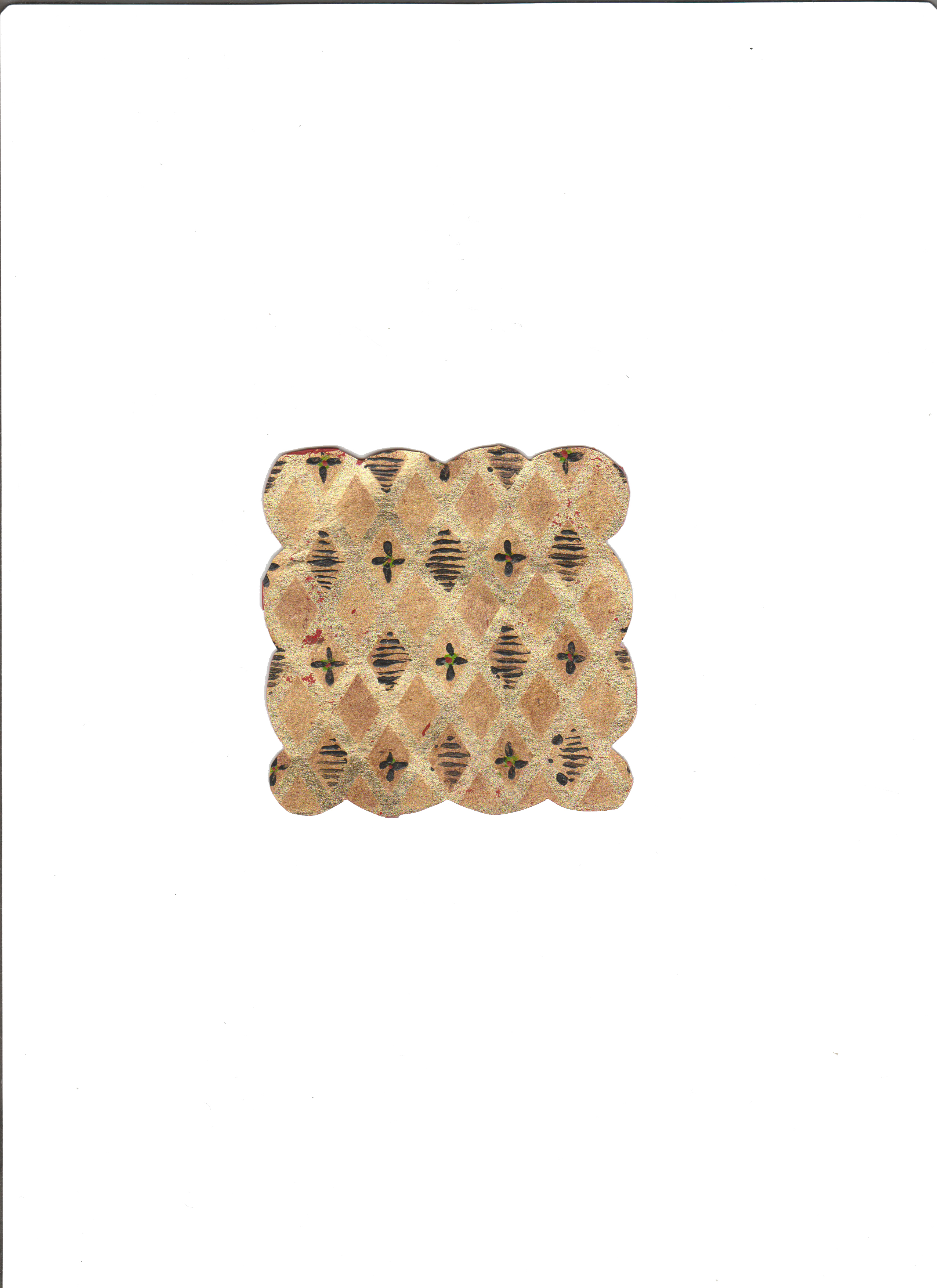

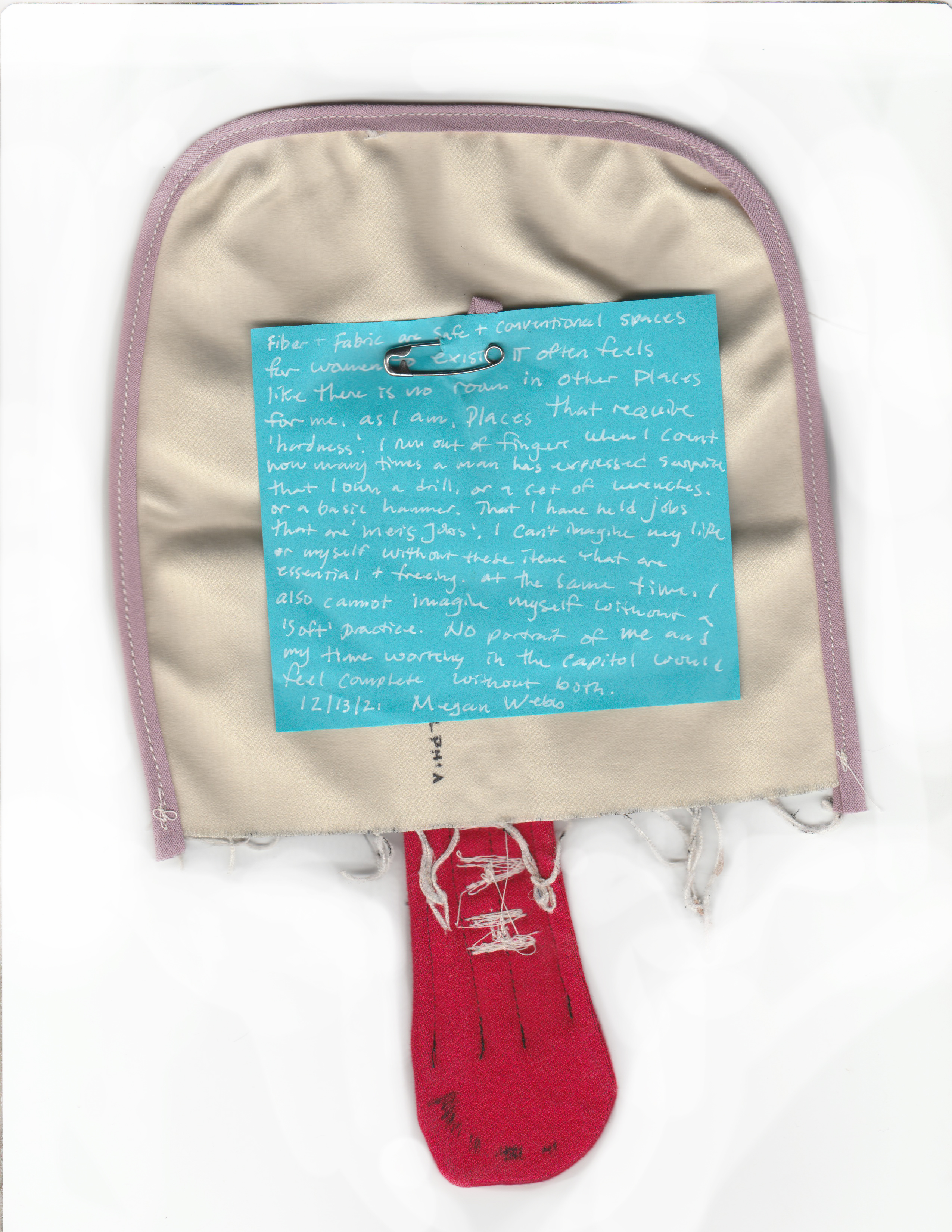



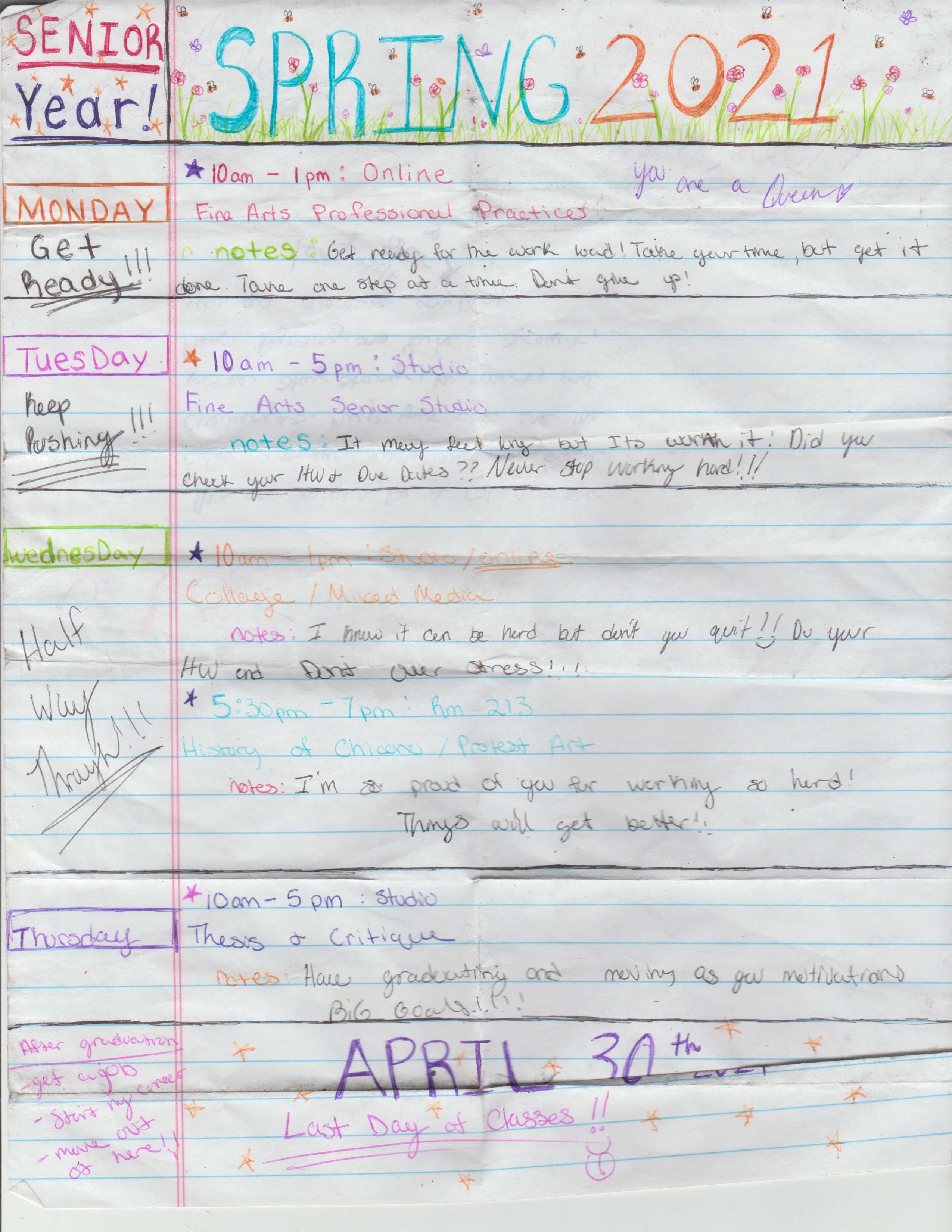
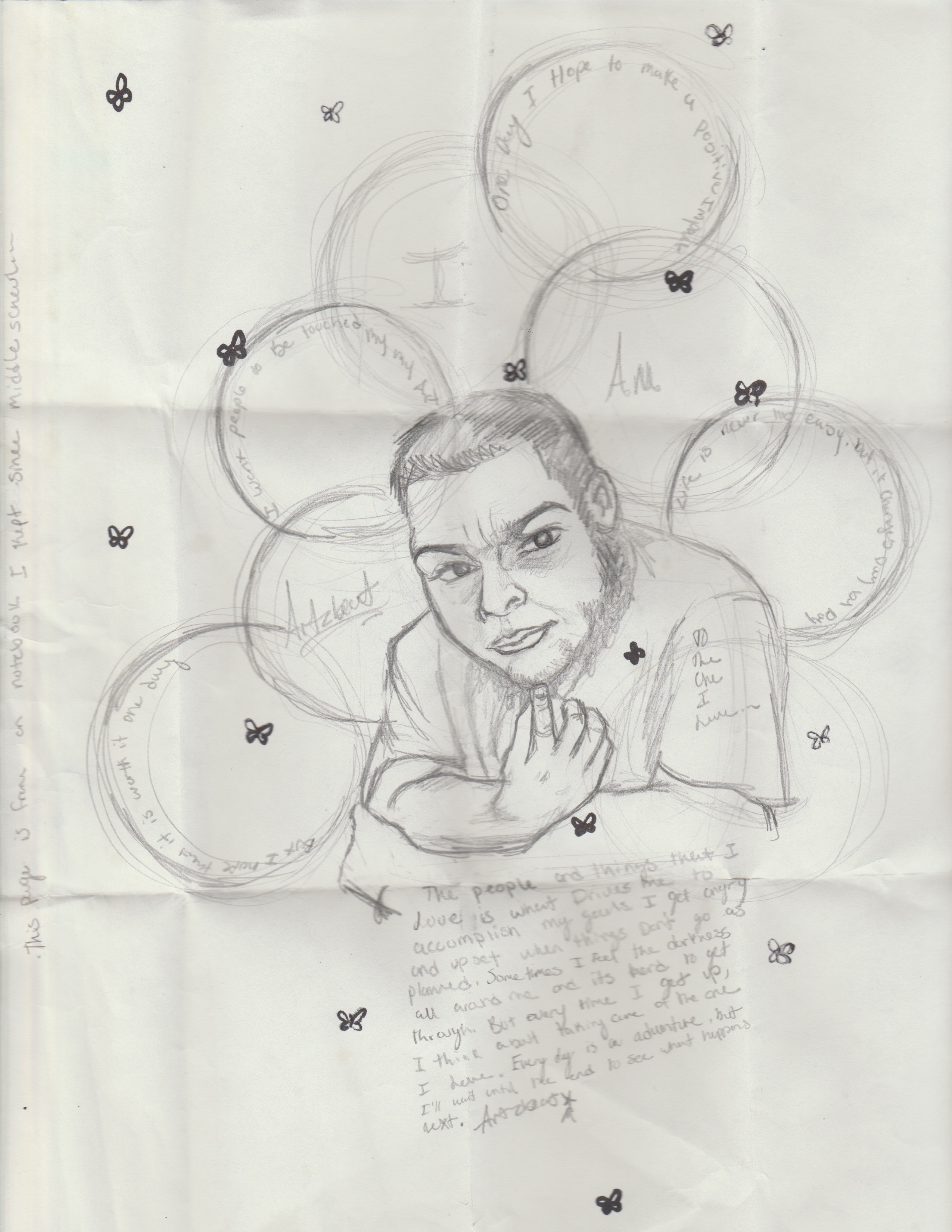

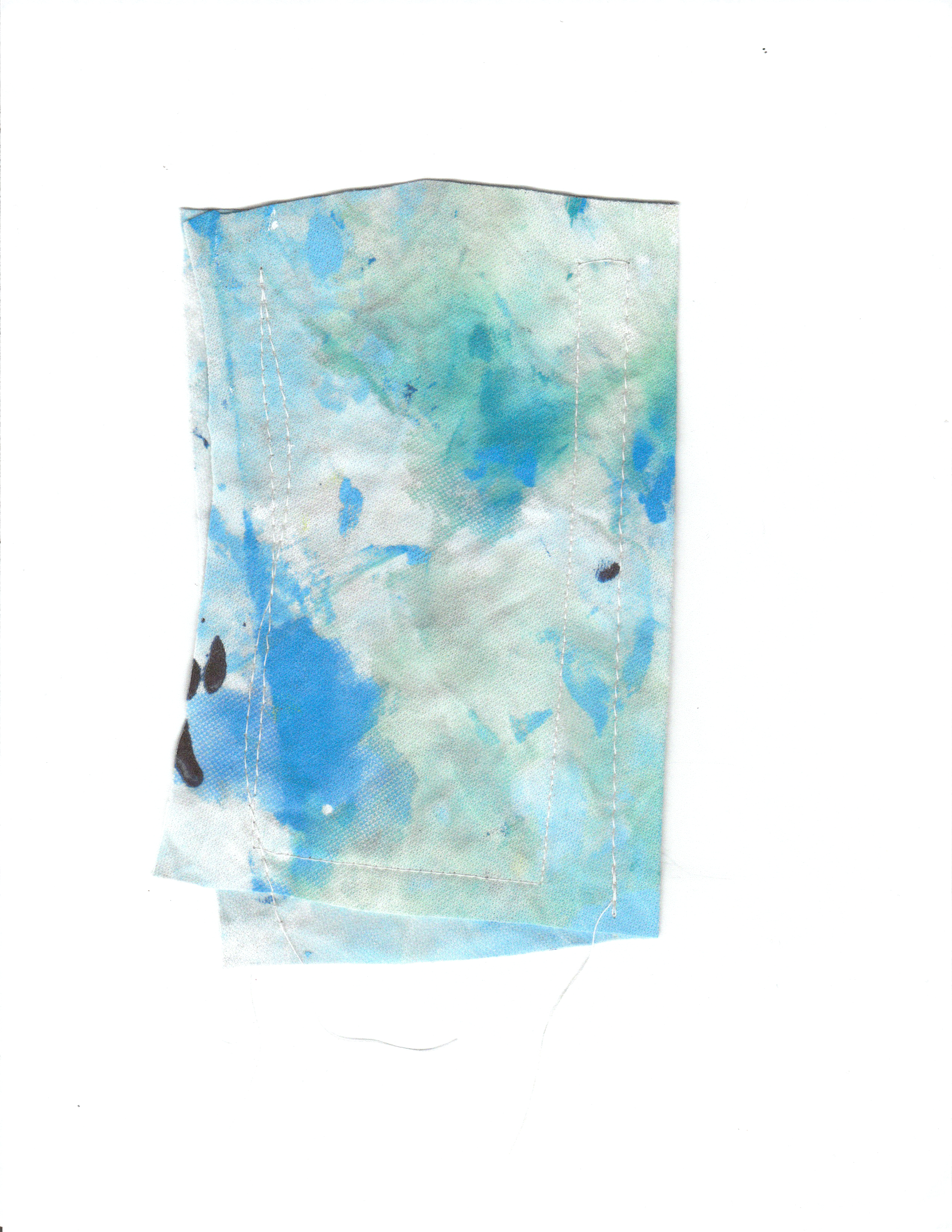



Starting with a Prompt
In the prompt I gave to our crew, I asked each person to consider physical symbols that represent them and their life experience. The objects they included hold personal meanings that contrast with but are also inspired by the broad range of imagery in each of the wall panels we worked on.
Personal experiences in this circumstance are individual and based on much more than gender, but through this crew, and ultimately this project, we carve out space for inclusion. Intentionally inclusive crews spread and multiply, and they influence the spaces we enter into.
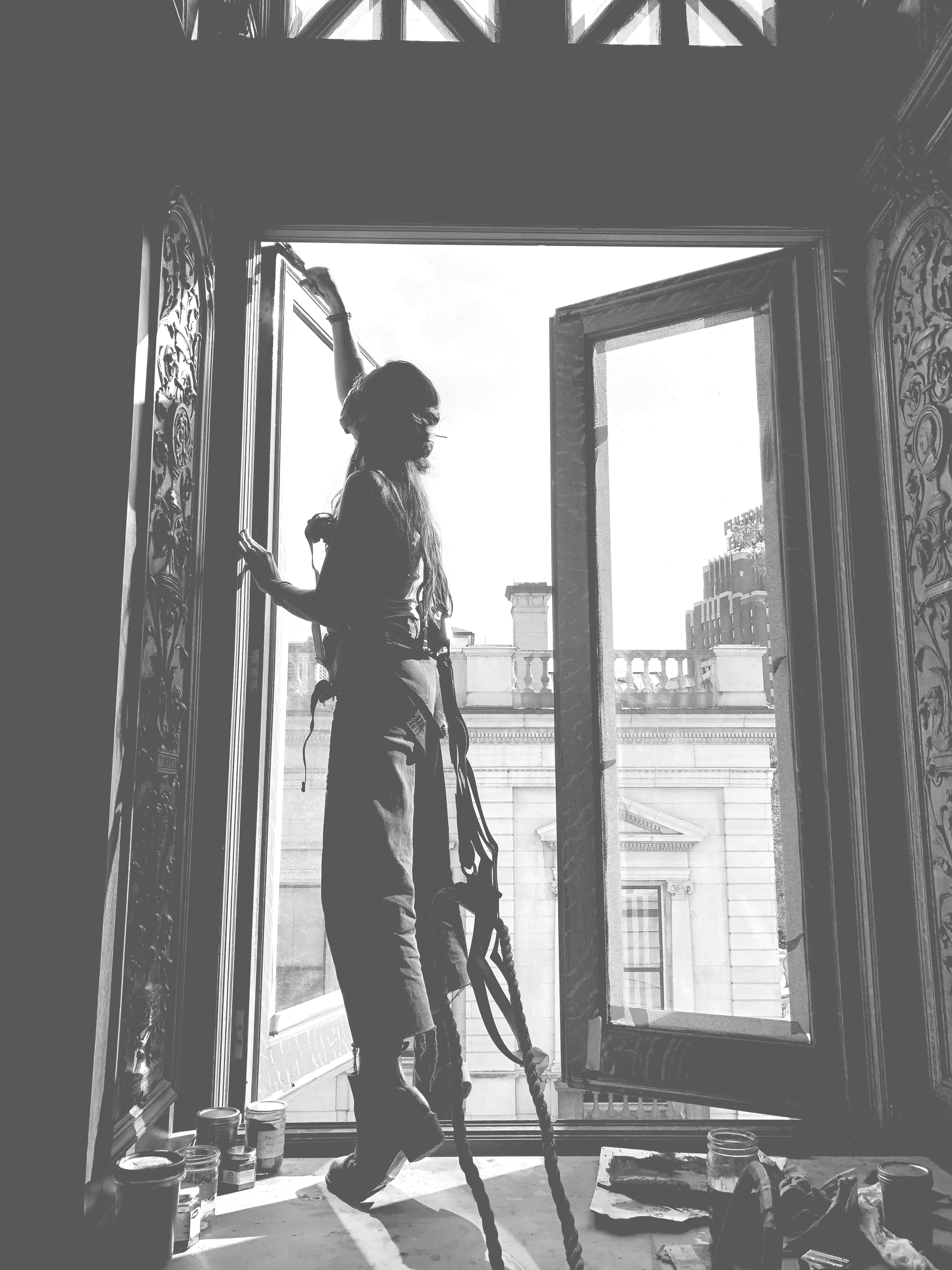





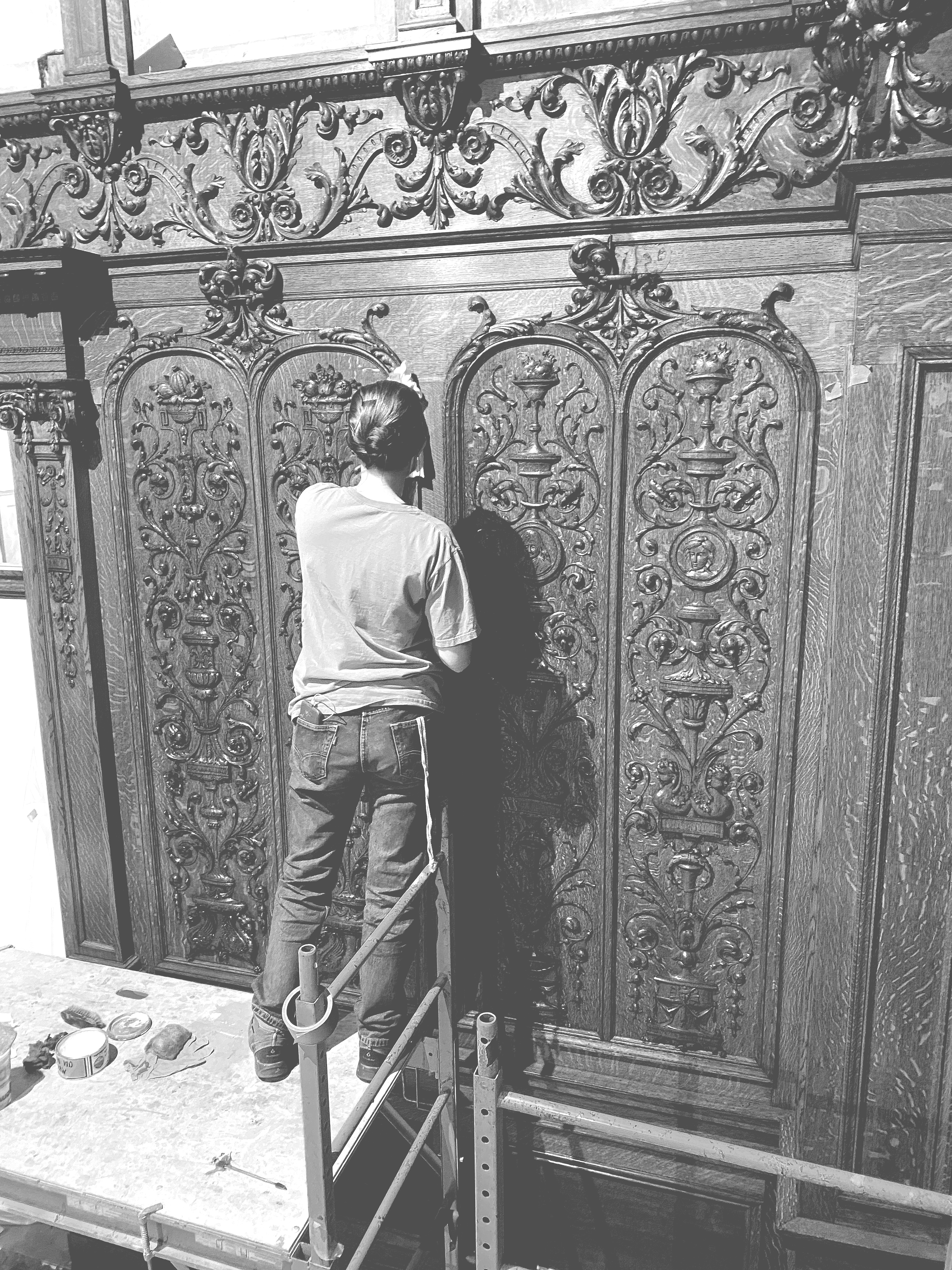

Red Tape Field Station
Participatory performance: weaving with linen on a custom portable loom
Presented as part of Portland Textile Month and made with support from Emma Duehr Mitchell and Shannon Welsh
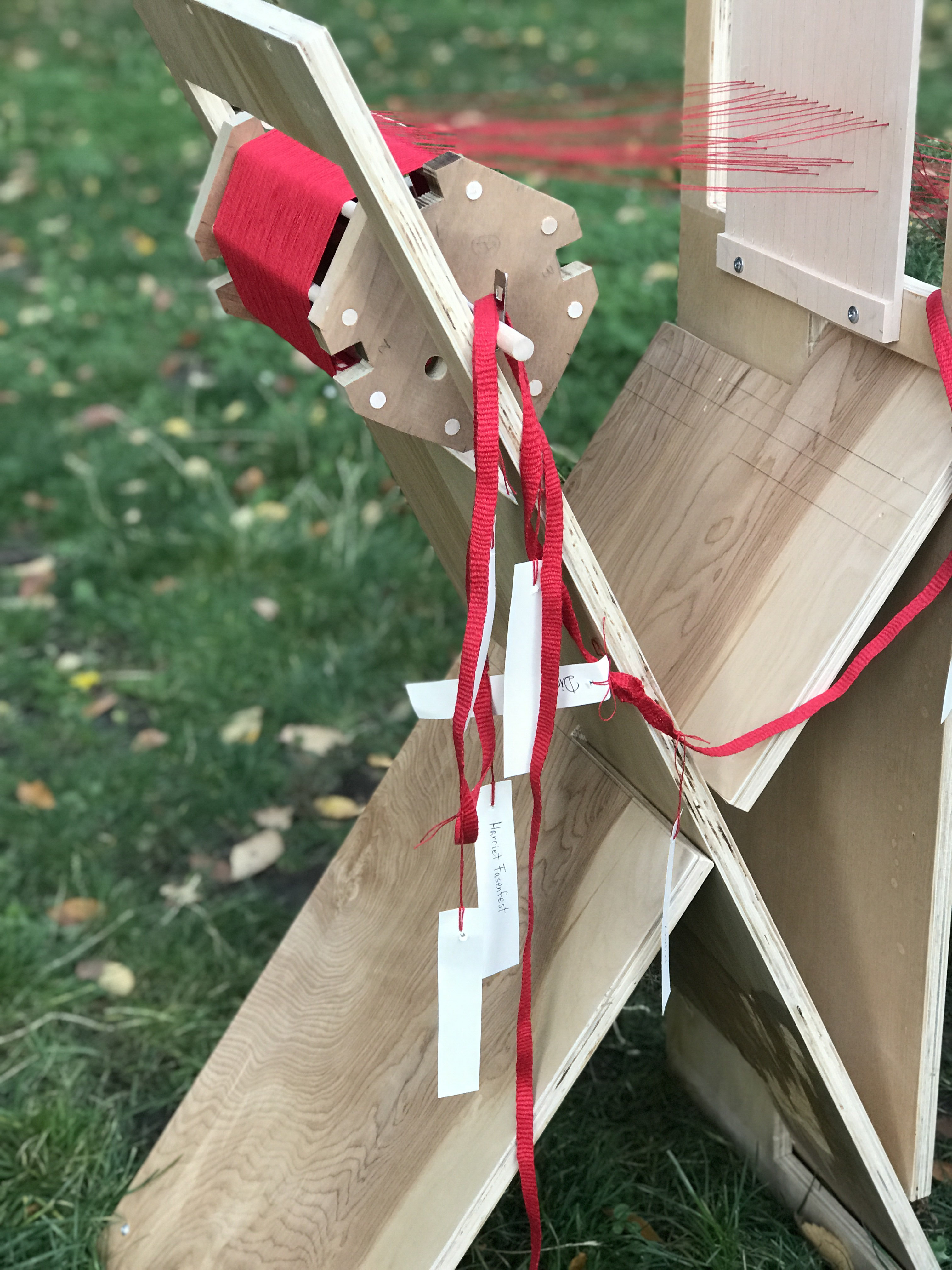
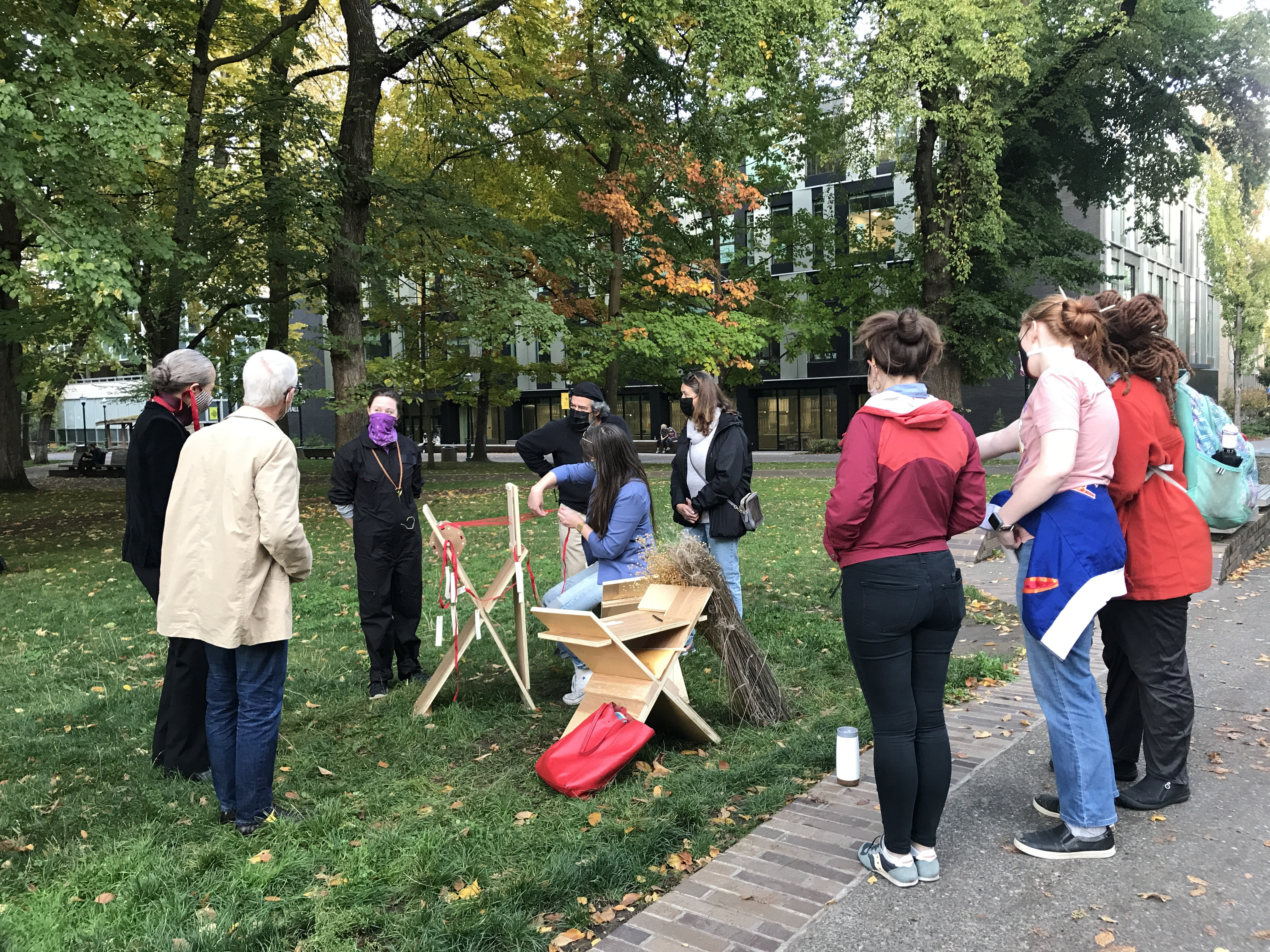
all photographs of the performance by Laura Glazer
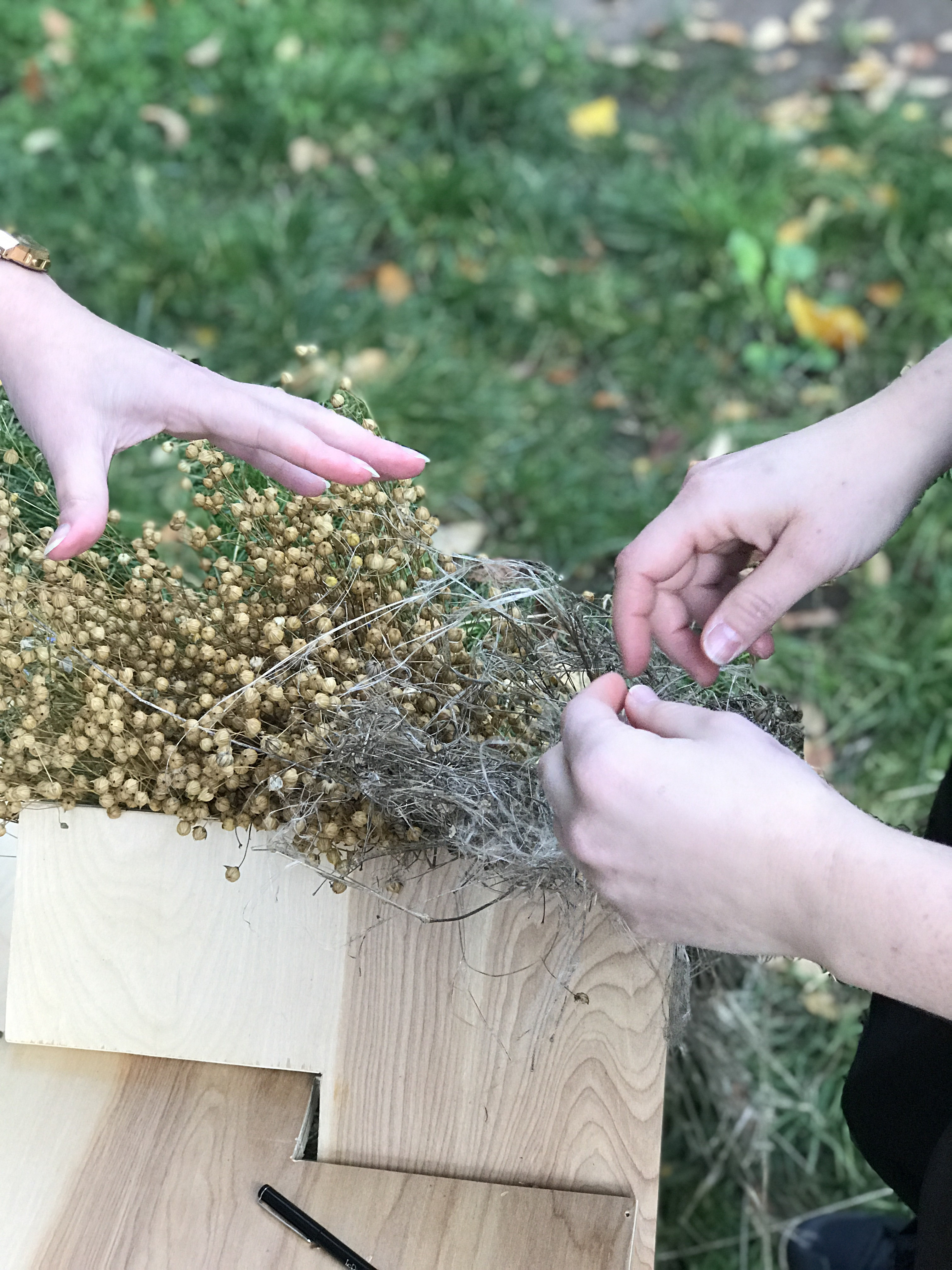
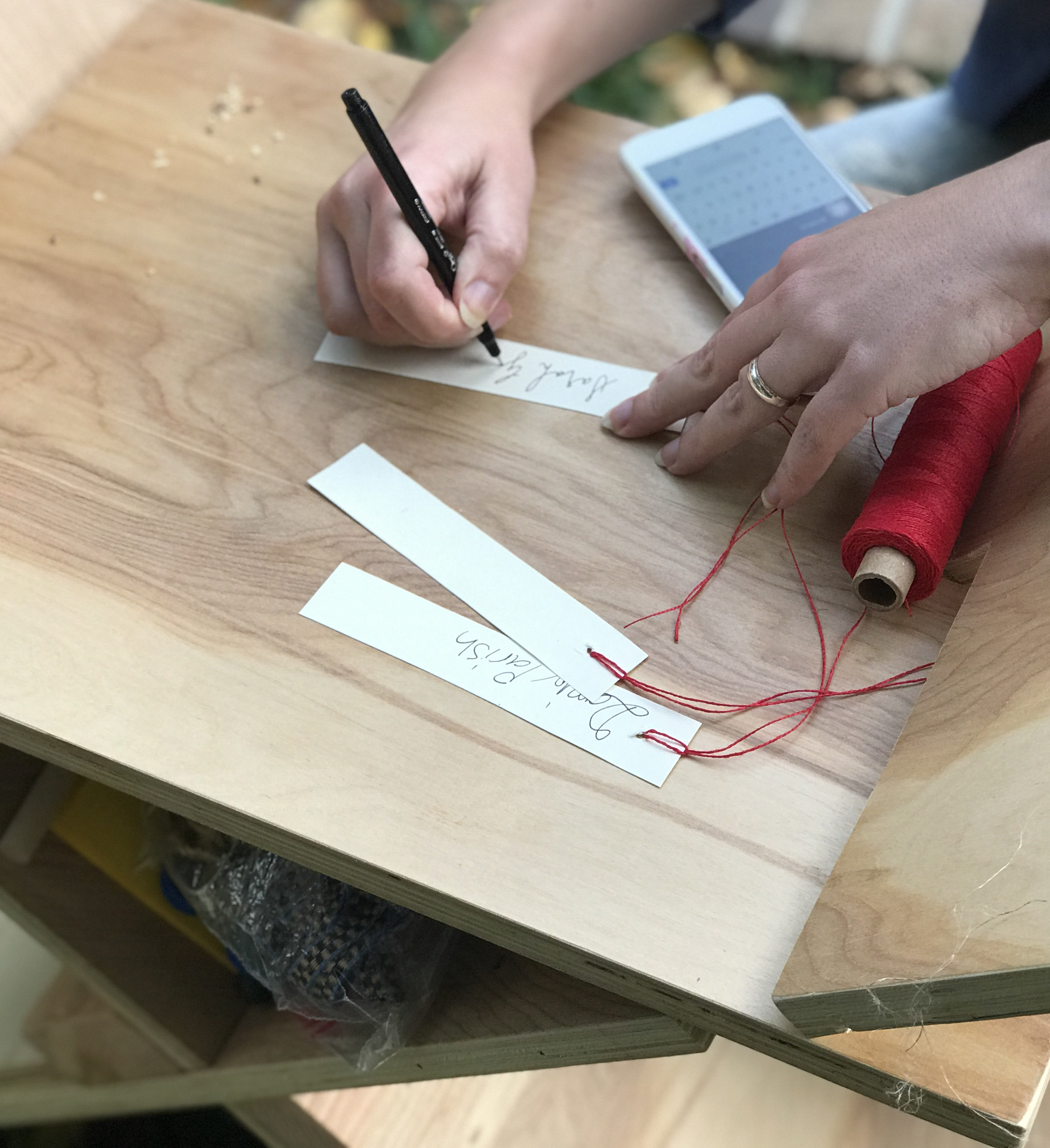
After setting up a portable, hand-built loom outside of the Portland State University Library, I began to weave a narrow linen band called “tape” and invited others to join. Tape is a woven material that takes many traditional forms around the world, and was used to tie materials and garments before other kinds of closures became common.
The Loom:
This loom is hand-tensioned and inspired by an 18th century tabletop box-loom reproduction: a copy of one originally used by my German ancestors in colonized early America. Showing visitors how to physically maintain tension in the threads with their upper bodies emphasized how all kinds of tension—personal, global, material, and cultural—can be held in this single narrow band. Each person who wove on the loom signed their names upon departure.
For 10 hours,
interpretations of “red tape” became personal, relating to the ways the that our bodies have become separated from textile material knowledge and the weaving process.The Loom:
This loom is hand-tensioned and inspired by an 18th century tabletop box-loom reproduction: a copy of one originally used by my German ancestors in colonized early America. Showing visitors how to physically maintain tension in the threads with their upper bodies emphasized how all kinds of tension—personal, global, material, and cultural—can be held in this single narrow band. Each person who wove on the loom signed their names upon departure.Construction and Material:
The modular loom and benches were constructed at the PSU workshops, now led by Emma Duehr Mitchell, who helped located appropriate scrap material for their construction. No new lumber was used. Shannon Welsh, of Fibrevolution in Portland, loaned bundles of dried and retted flax as interpretive tools for the performance.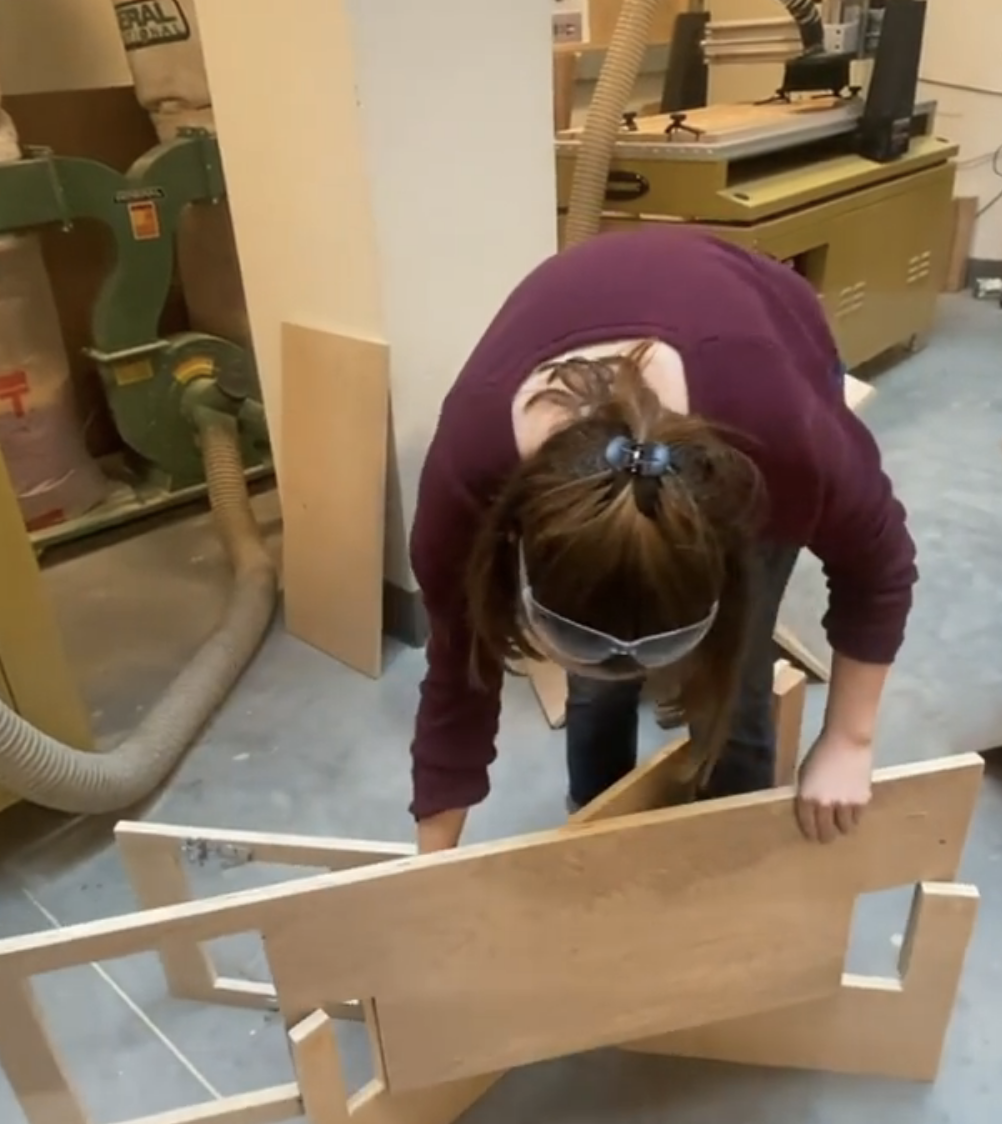
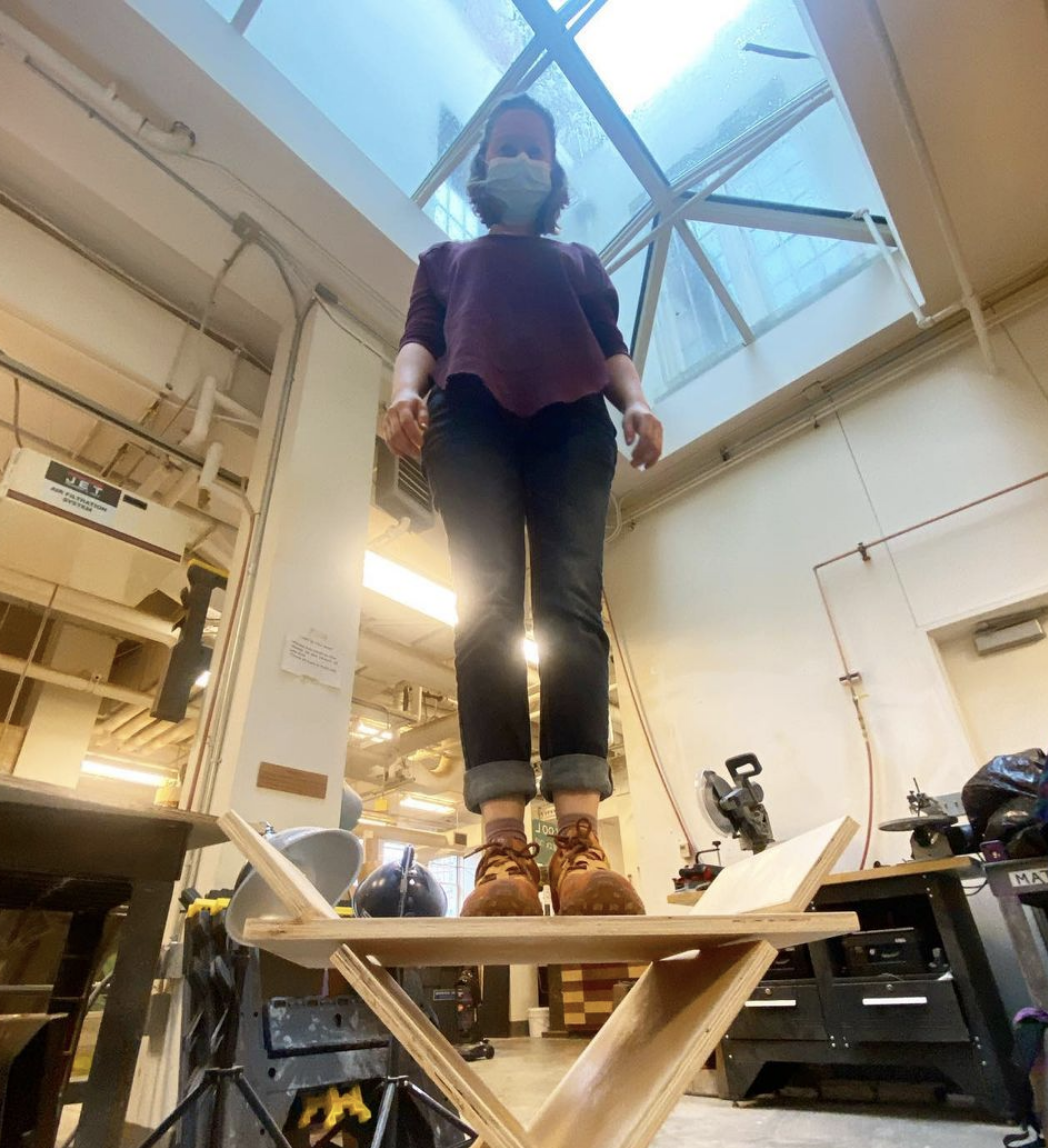
Persephone on the Water
2021Public performance on the beach at Laurel Lake — a former industrial iron forge site in the mountains of central Pennsylvania
made with Valley Traction Performance Collective
Bringing together musicians, dancers, and other contributers, this devised piece was a raucous, tongue-in-cheek, occupation of public space. The score asked the audience to shout, sing along, and swim in the water at the show’s conclusion. There were moments of peace and moments of cacophany, and we invited passerby to join in. Dynamic sound was a key element of our experimentation on the water.
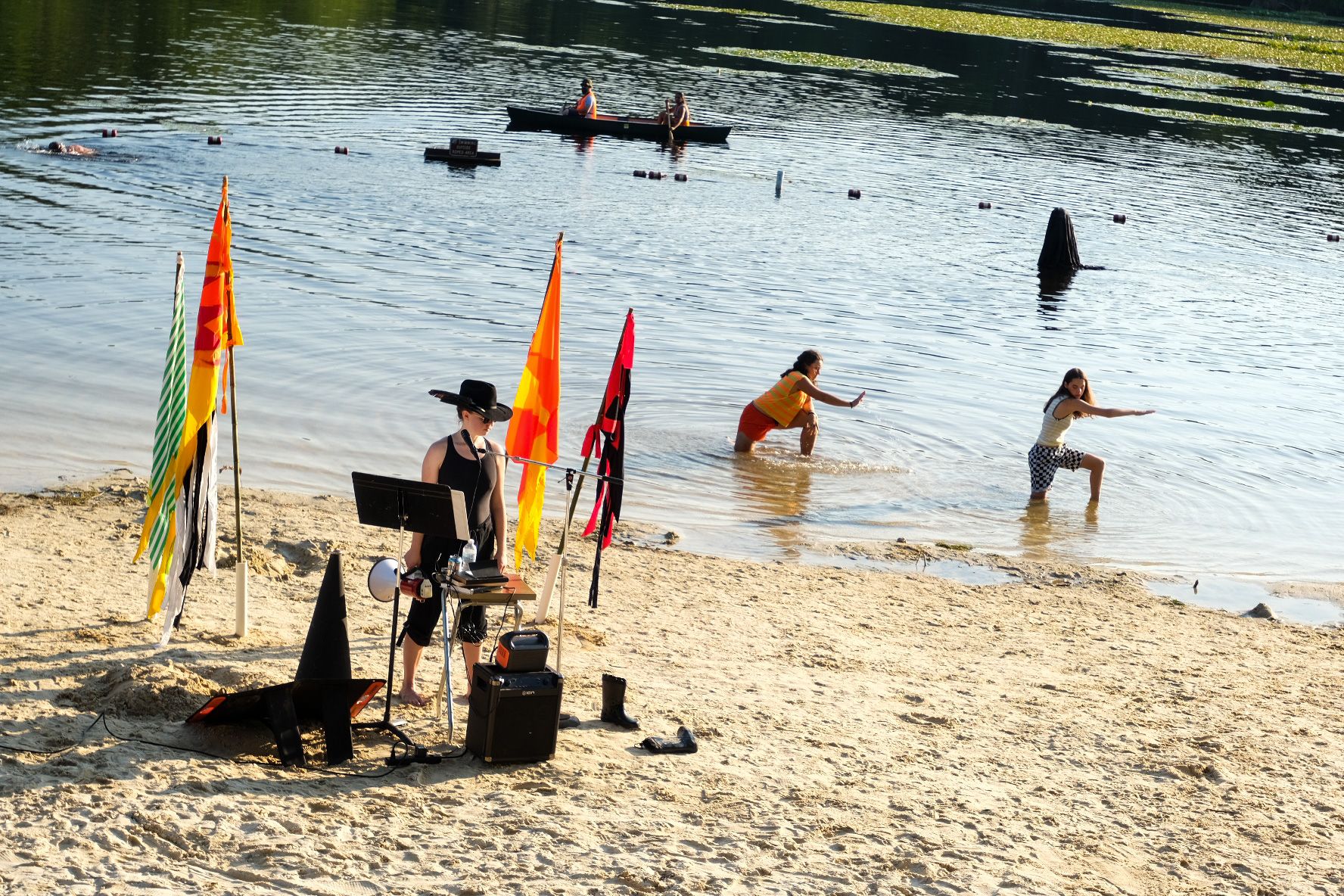

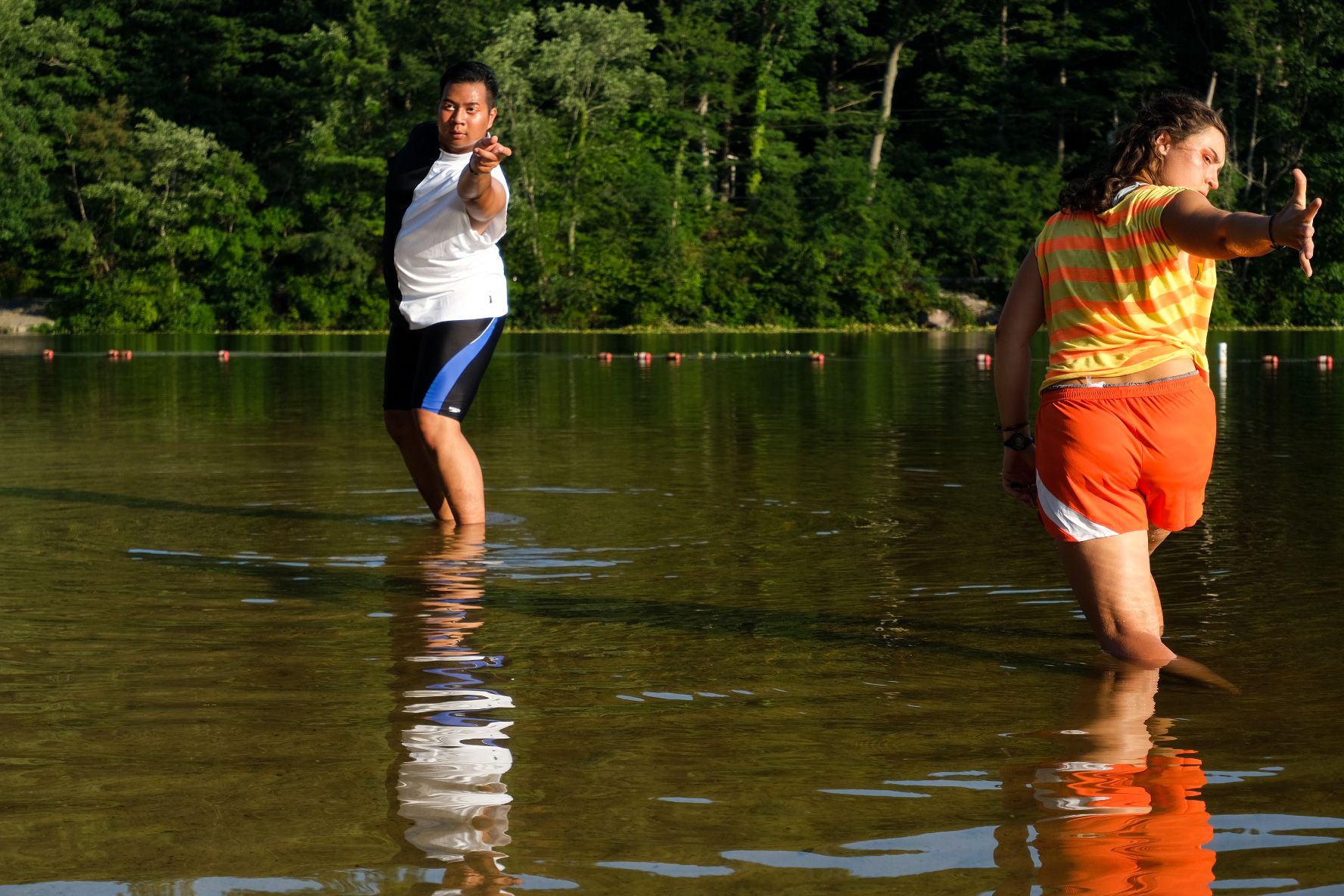
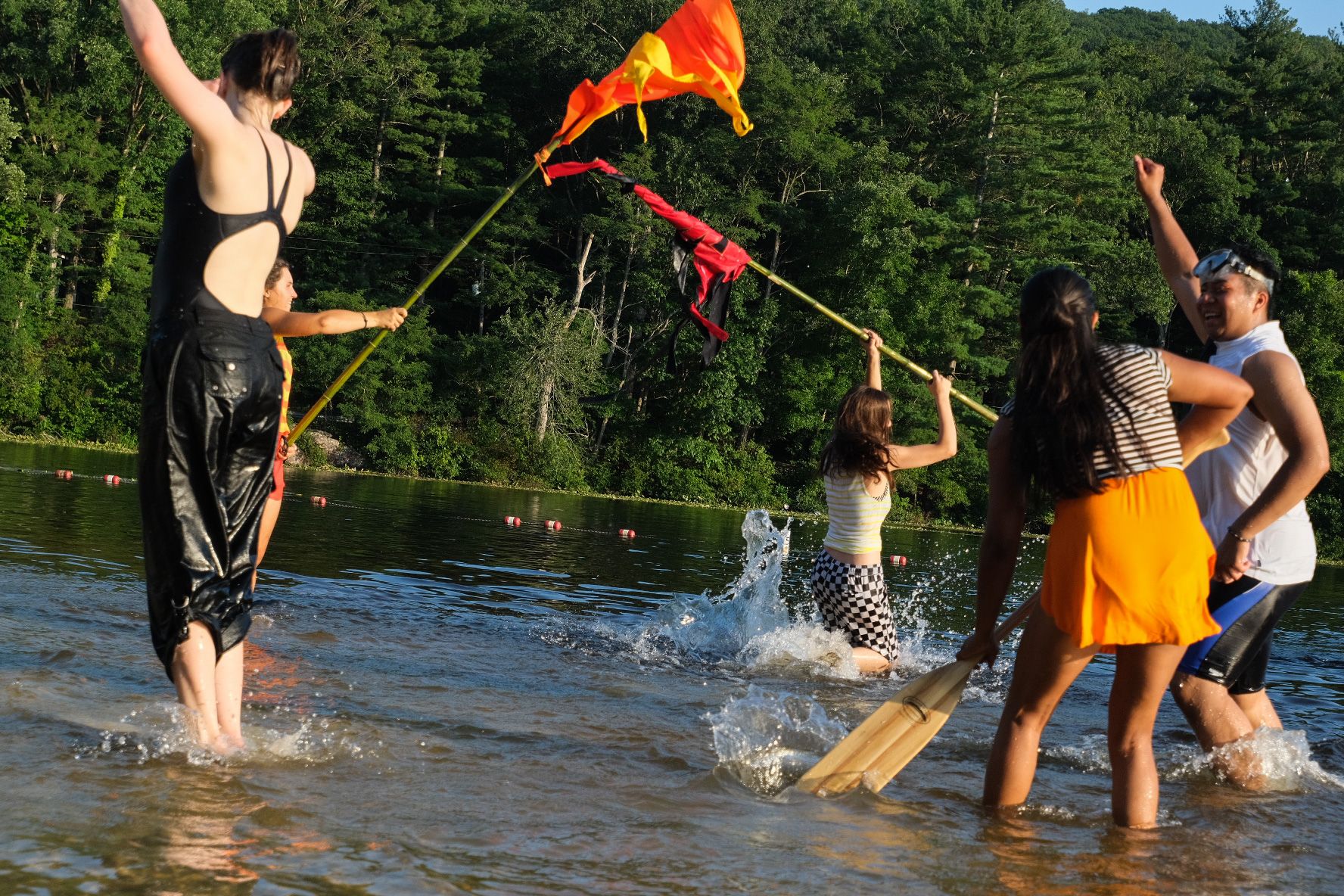
“The hardest thing for me to understand is boredom...”
— Alice Mackenzie Swaim
poet from Mt. Holly Springs, PA
The railroad coming, the beginning of the end
The end of silence, The end of solace,
The end of smokeless summers
Not a place, but a part of one
Not a place, but apart from one
Not a whole, but apart from one
— “Change Train”
song from the show’s score
The end of silence, The end of solace,
The end of smokeless summers
Not a place, but a part of one
Not a place, but apart from one
Not a whole, but apart from one
— “Change Train”
song from the show’s score
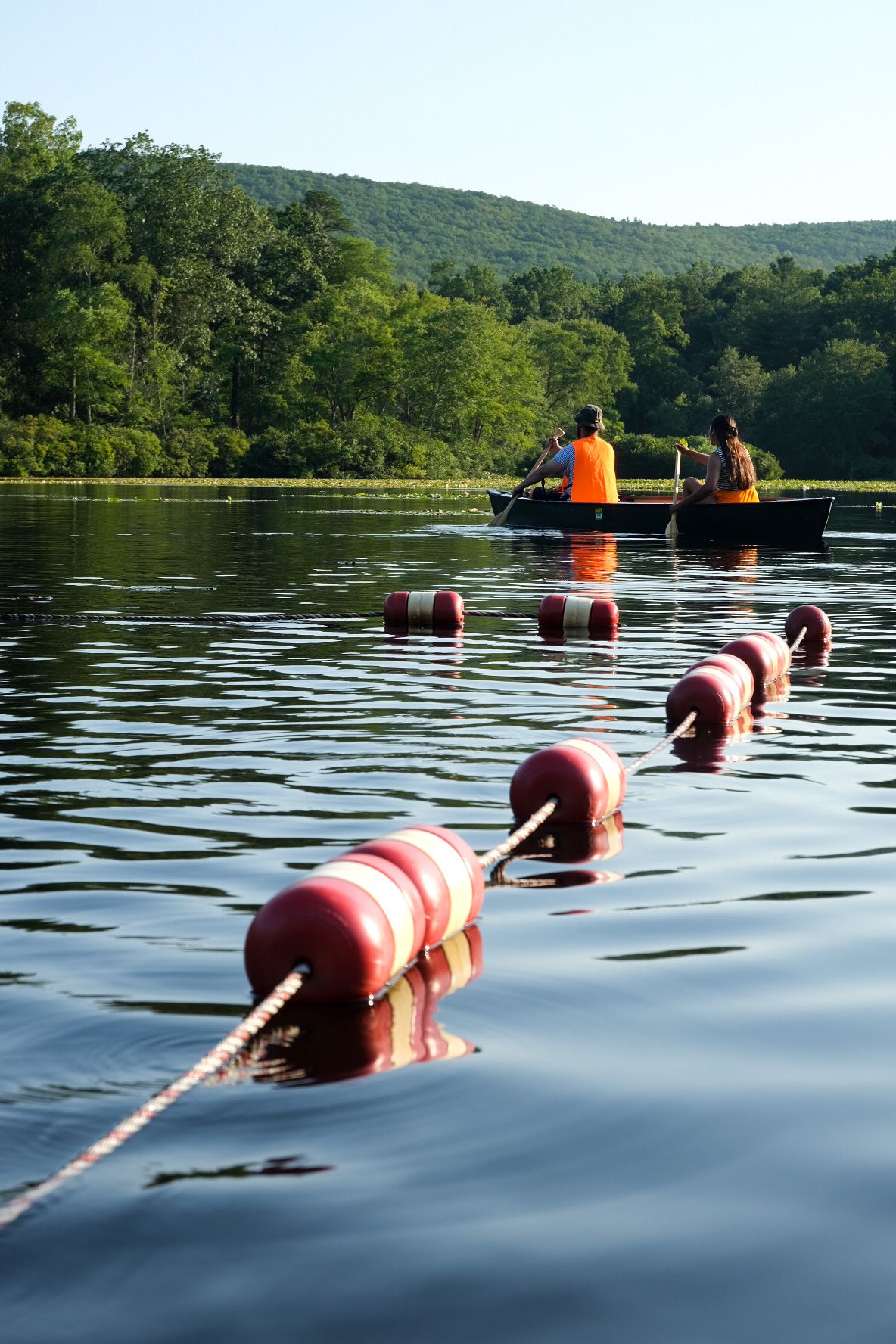


Persephone on the Water was performed by speakers, dancers, and live musicians on the shore of Laurel Lake in Pine Grove Furnace State Park, Pennsylvania. Two speakers were on the shore, 3 dancers move between the beach and the shallows, a group of musicians is gathered on the sand, and a saxophonist traverses the lake in a canoe.
Persephone’s story is a myth that in traditional readings explains the earth’s four seasons, and it became a jumping-off point for this original work. Persephone is in all of us, and the dark side of our relationship to the natural world—its mechanization and exploitation—is inside of us too. We all can hike and remark on the beauty of a sunrise, but we exist knowing that there’s always darkness. Using the history of Laurel Lake, we described Persephones’ abduction by Hades and eventual return at the behest of her mother Demeter—which for her became a perpetual cycle of dormancy and revival as cursed Queen of the Underworld.
Persephone’s story is a myth that in traditional readings explains the earth’s four seasons, and it became a jumping-off point for this original work. Persephone is in all of us, and the dark side of our relationship to the natural world—its mechanization and exploitation—is inside of us too. We all can hike and remark on the beauty of a sunrise, but we exist knowing that there’s always darkness. Using the history of Laurel Lake, we described Persephones’ abduction by Hades and eventual return at the behest of her mother Demeter—which for her became a perpetual cycle of dormancy and revival as cursed Queen of the Underworld.
A megaphone, saxophone, battery-powered keyboard, and acoustic percussion all provided nuanced reverberation in the valley that had once been filled with the pounding of an iron furnace and the roar of fires. We all experienced the lake in a new way during this process, hearkenign back to the days when water from the lake powered the production of iron.
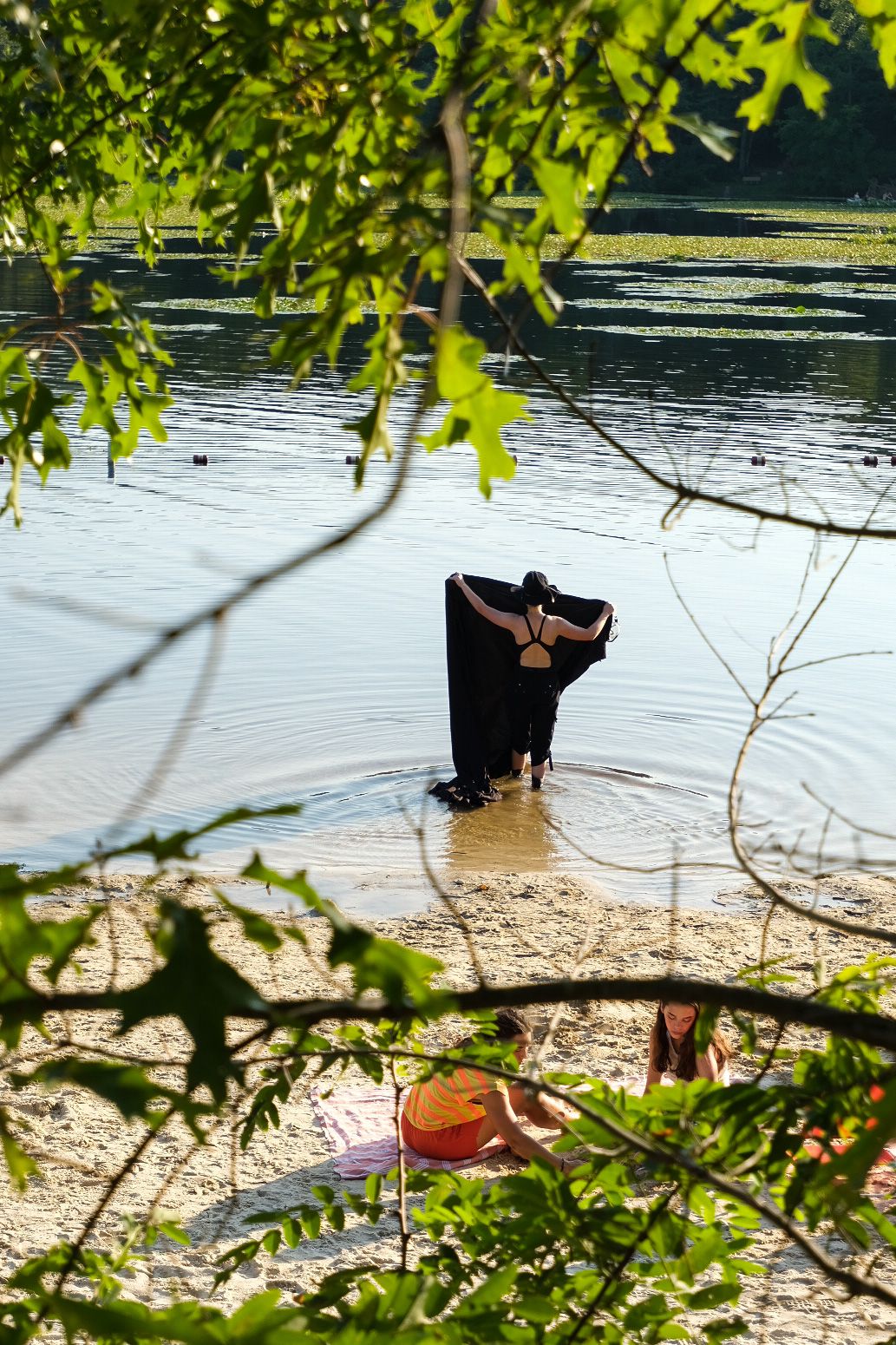
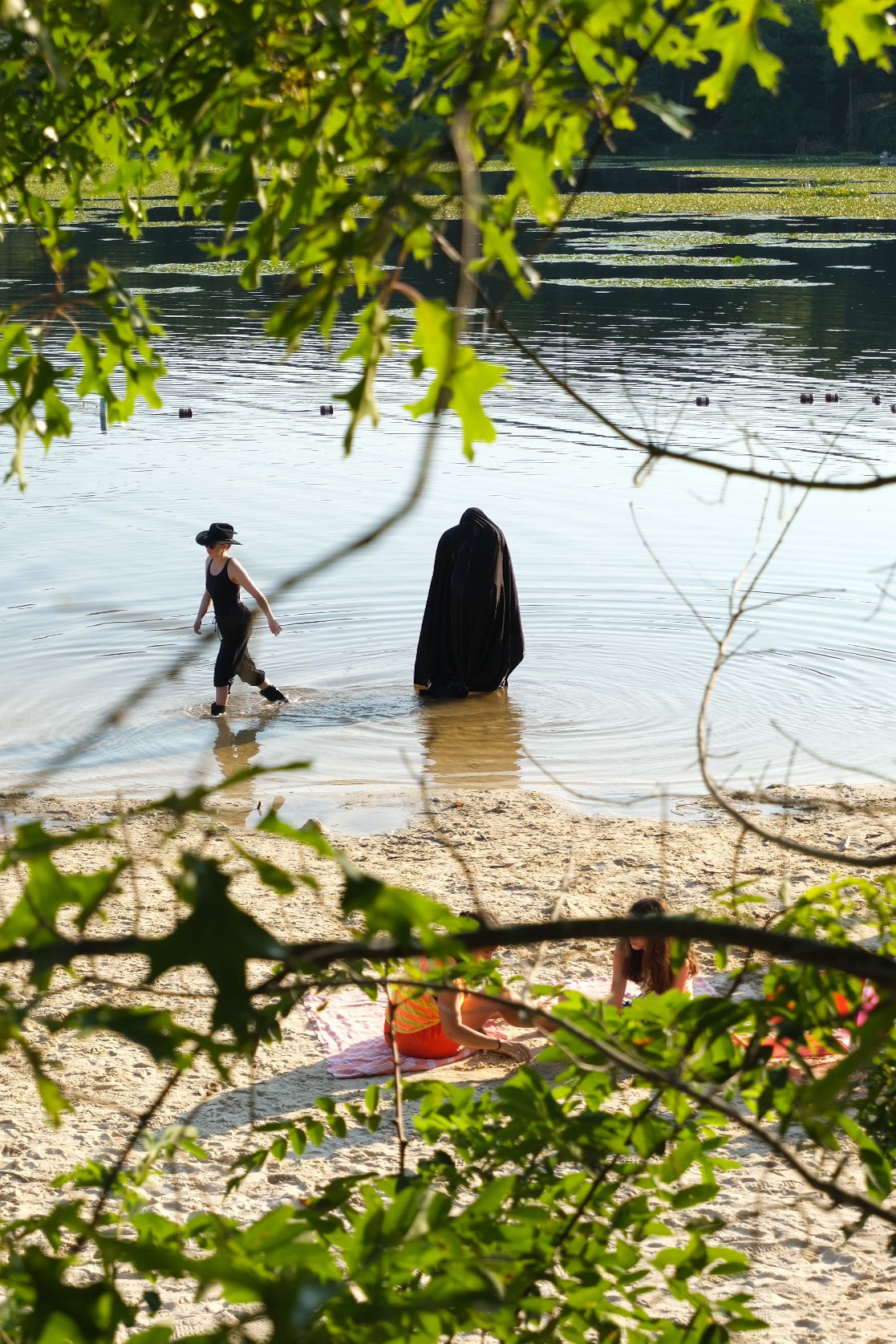
“Everything that comes into the waterbody dies and settles in layers, and we use that to go back in time... We can detect fossil records in the sediment. Every organism that lives there tells me something about the quality of the waterbody or the activities on the landscape.”
—Dr. Kristin Strock
freshwater ecologist who has
monitered Laurel Lake for 8 years
—Dr. Kristin Strock
freshwater ecologist who has
monitered Laurel Lake for 8 years
Valley Traction production team:
Kent Barrett
Mo Geiger
John Werner
Chakra Sokhomsan (Dickinson College
Dana Assistant, Summer 2021)
CAST:
YOUNG PERSEPHONE….……Roma Cervino
PERSEPHONE………...…..……...Chakra Sokhomsan
DEMETER………………….…..…….Espoir DelMain
H………………..…….………….………..Mo Geiger
FOOTNOTE………….......……….…Rory Harper-McCombs
THE COMPOSER ….……..……..Brian Maag
THE ARCHITECT……………...…..Walt Geiger
MUSICIAN 1……….………....……..Joshua Bennett
MUSICIAN 2……….……….…….…John Werner
MUSICIAN 3…….…………….…....Harmony Esqueda
MUSICIAN 4…….…………….....….Doug Krueger
MUSICIAN 5………………..…….….Nate Smith
MUSICIAN 6…..……………..……...Andrew Lubimtsev
MUSICIAN 7……………………..…...Jeff Adams
MUSICIAN 8……………...…...…….Sara Markowitz
YOUNG PERSEPHONE….……Roma Cervino
PERSEPHONE………...…..……...Chakra Sokhomsan
DEMETER………………….…..…….Espoir DelMain
H………………..…….………….………..Mo Geiger
FOOTNOTE………….......……….…Rory Harper-McCombs
THE COMPOSER ….……..……..Brian Maag
THE ARCHITECT……………...…..Walt Geiger
MUSICIAN 1……….………....……..Joshua Bennett
MUSICIAN 2……….……….…….…John Werner
MUSICIAN 3…….…………….…....Harmony Esqueda
MUSICIAN 4…….…………….....….Doug Krueger
MUSICIAN 5………………..…….….Nate Smith
MUSICIAN 6…..……………..……...Andrew Lubimtsev
MUSICIAN 7……………………..…...Jeff Adams
MUSICIAN 8……………...…...…….Sara Markowitz
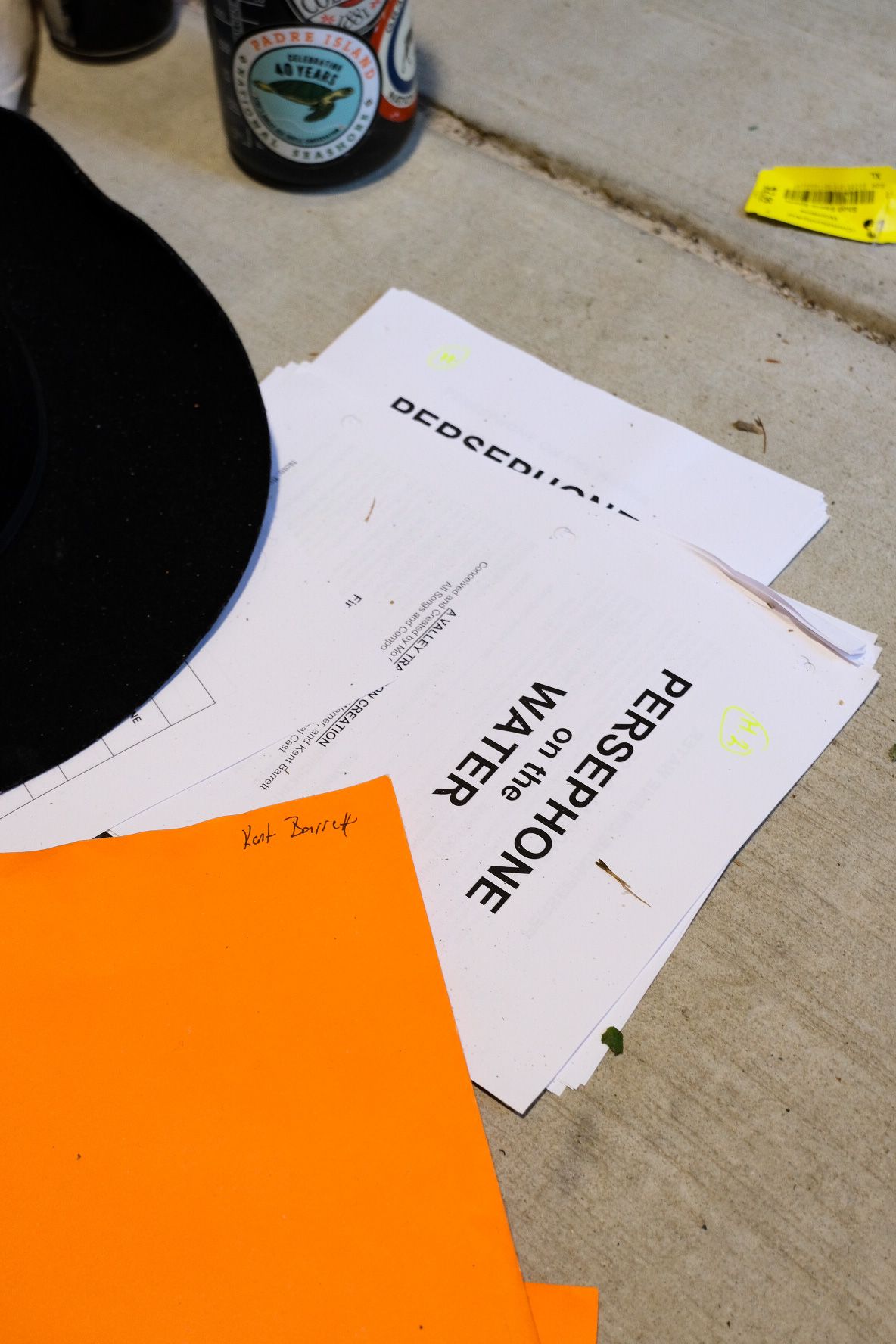

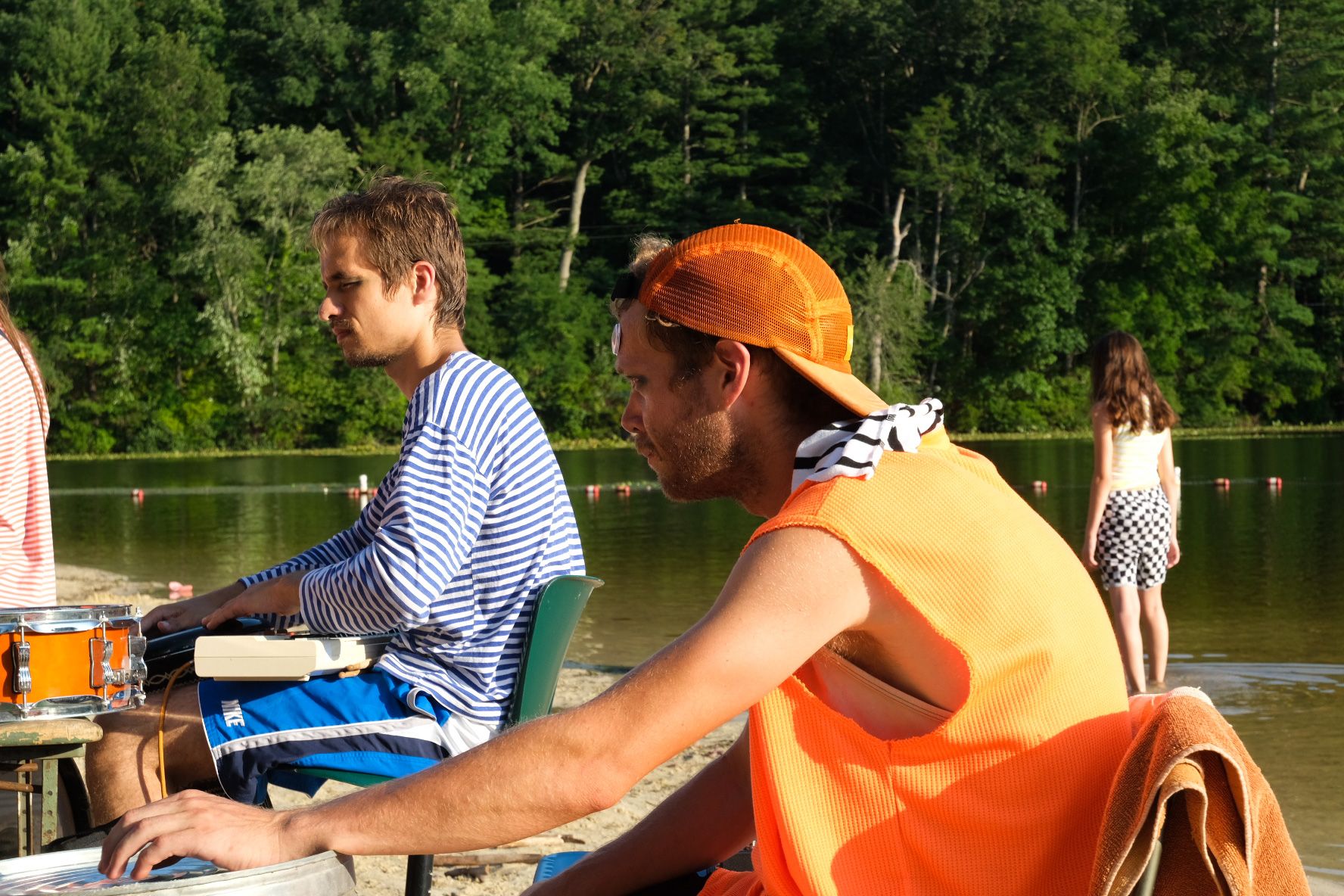
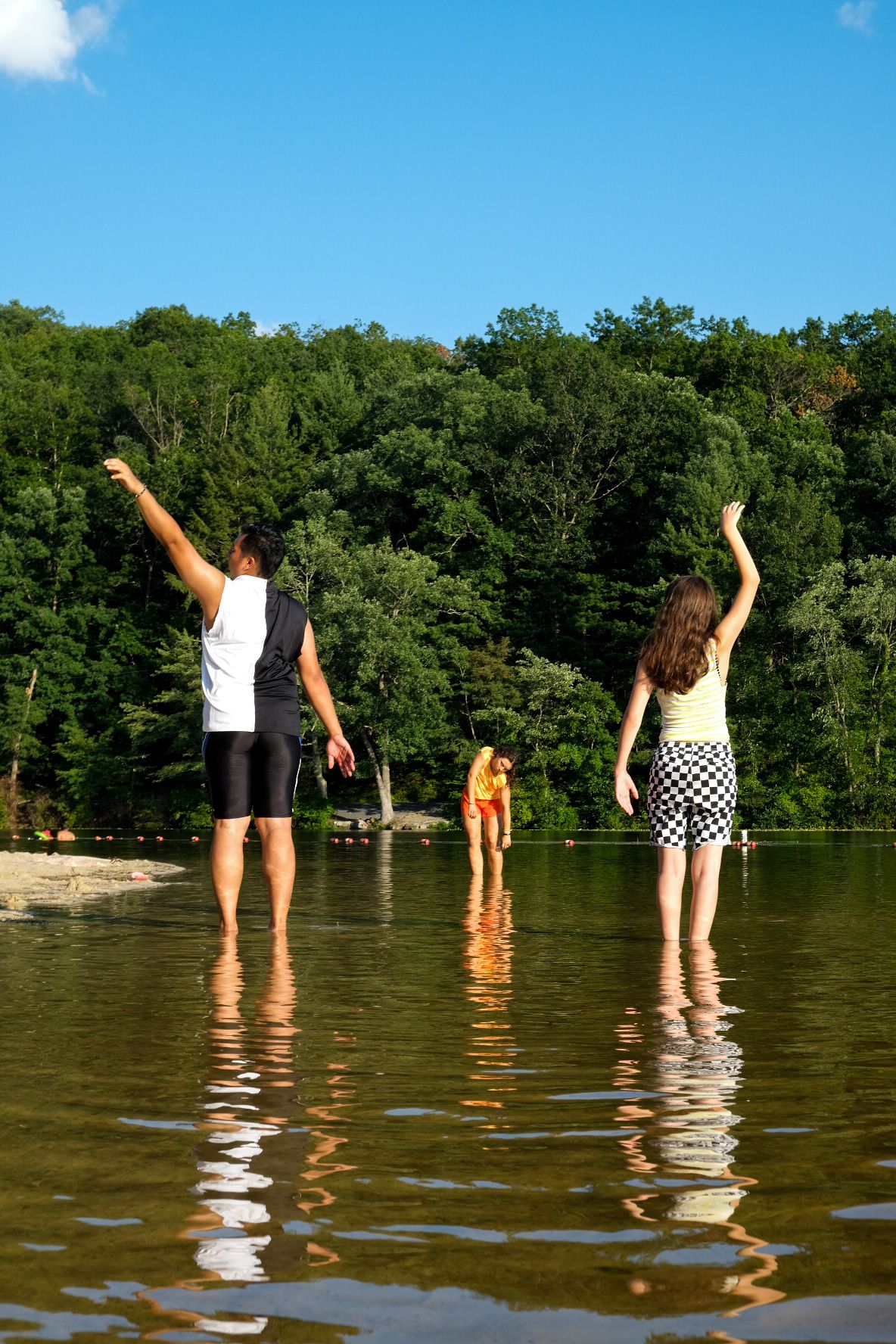
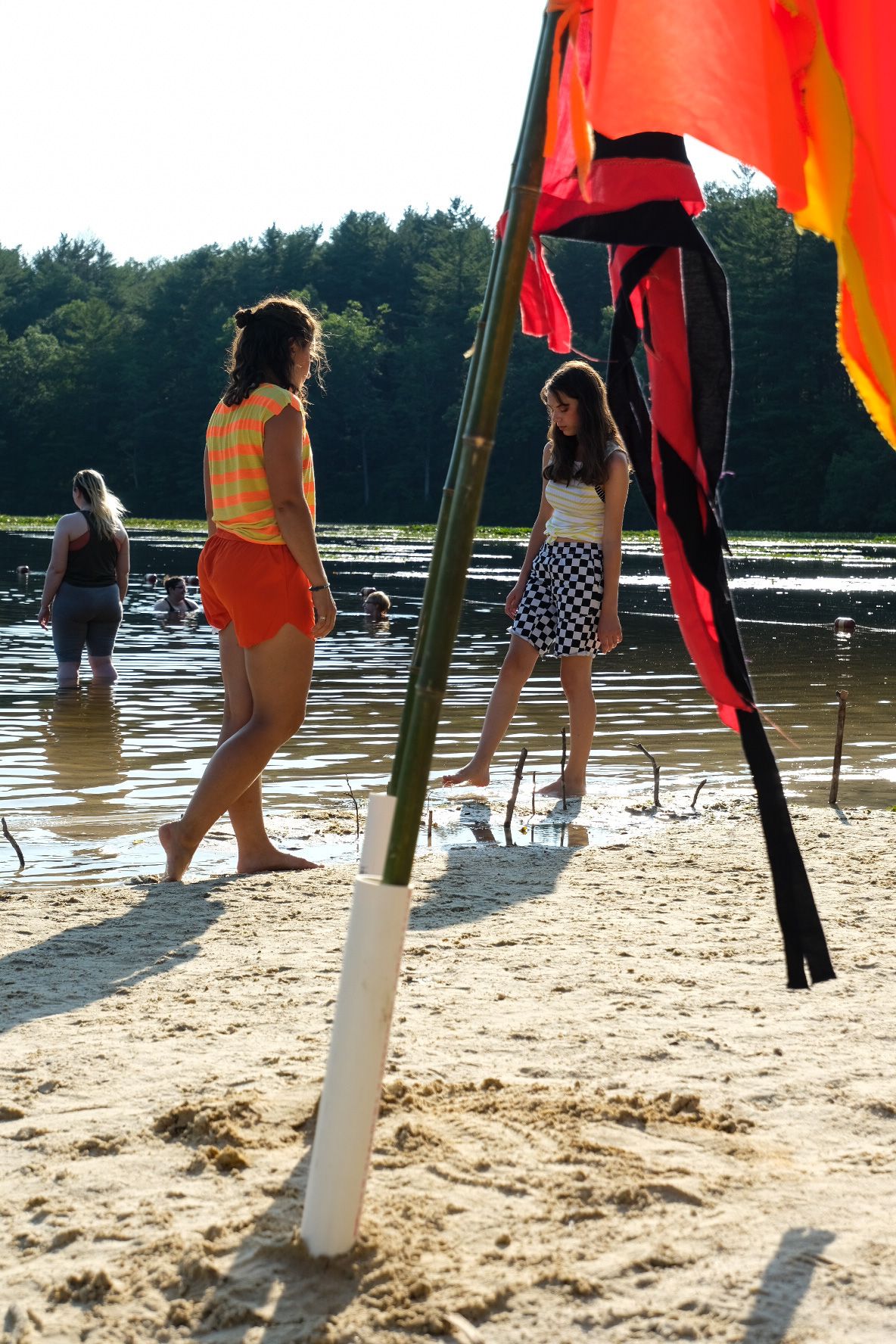
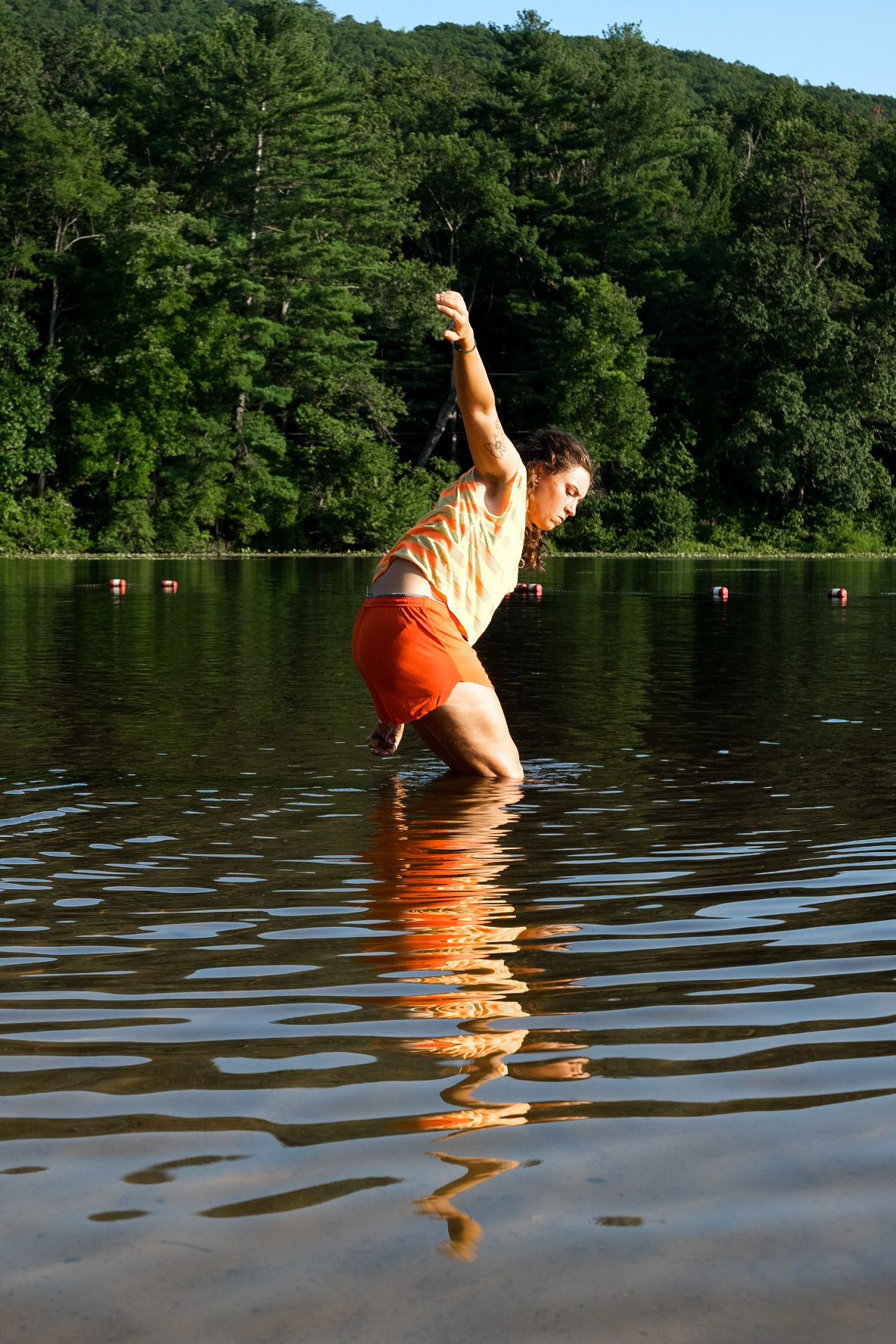
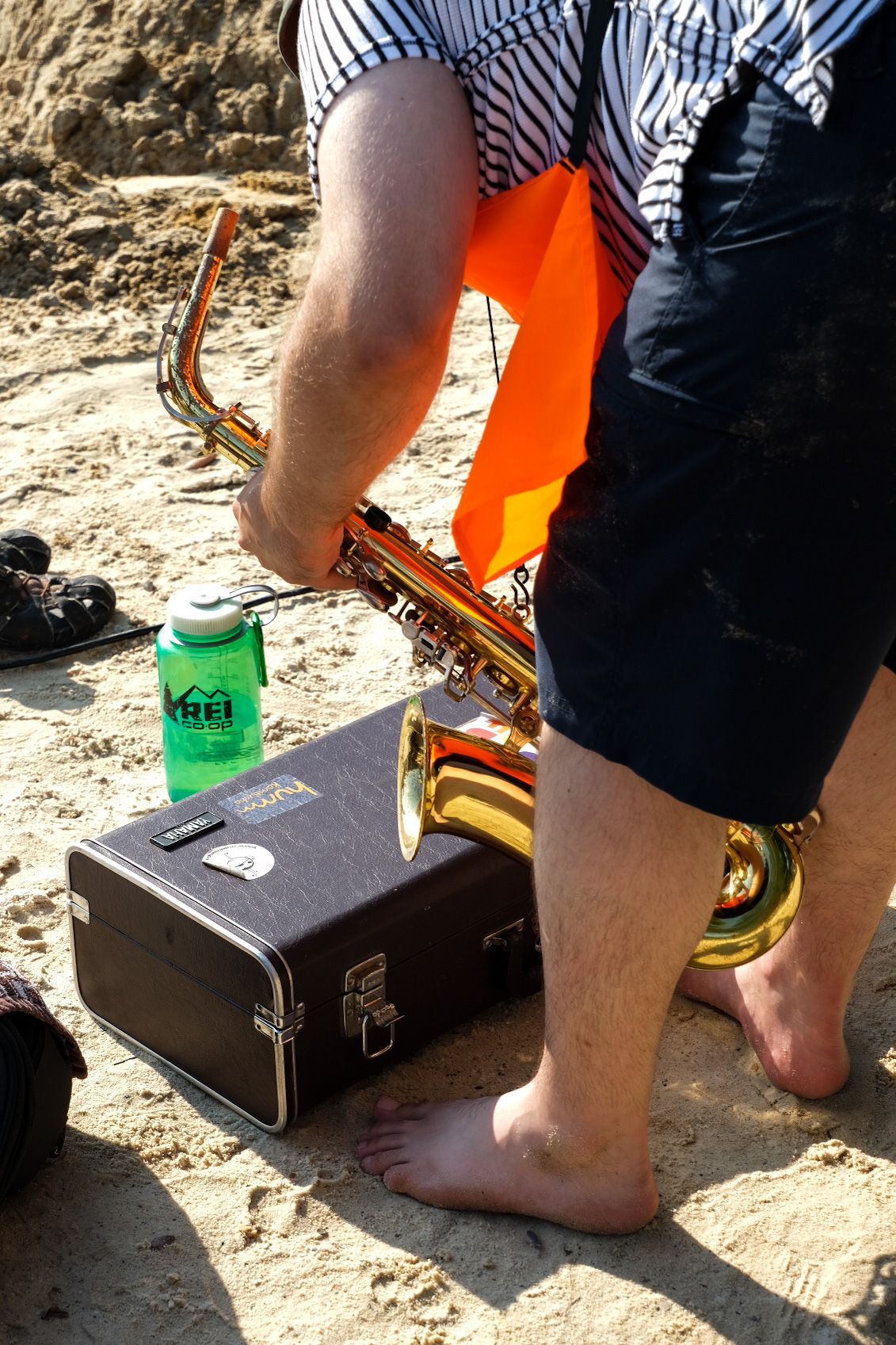
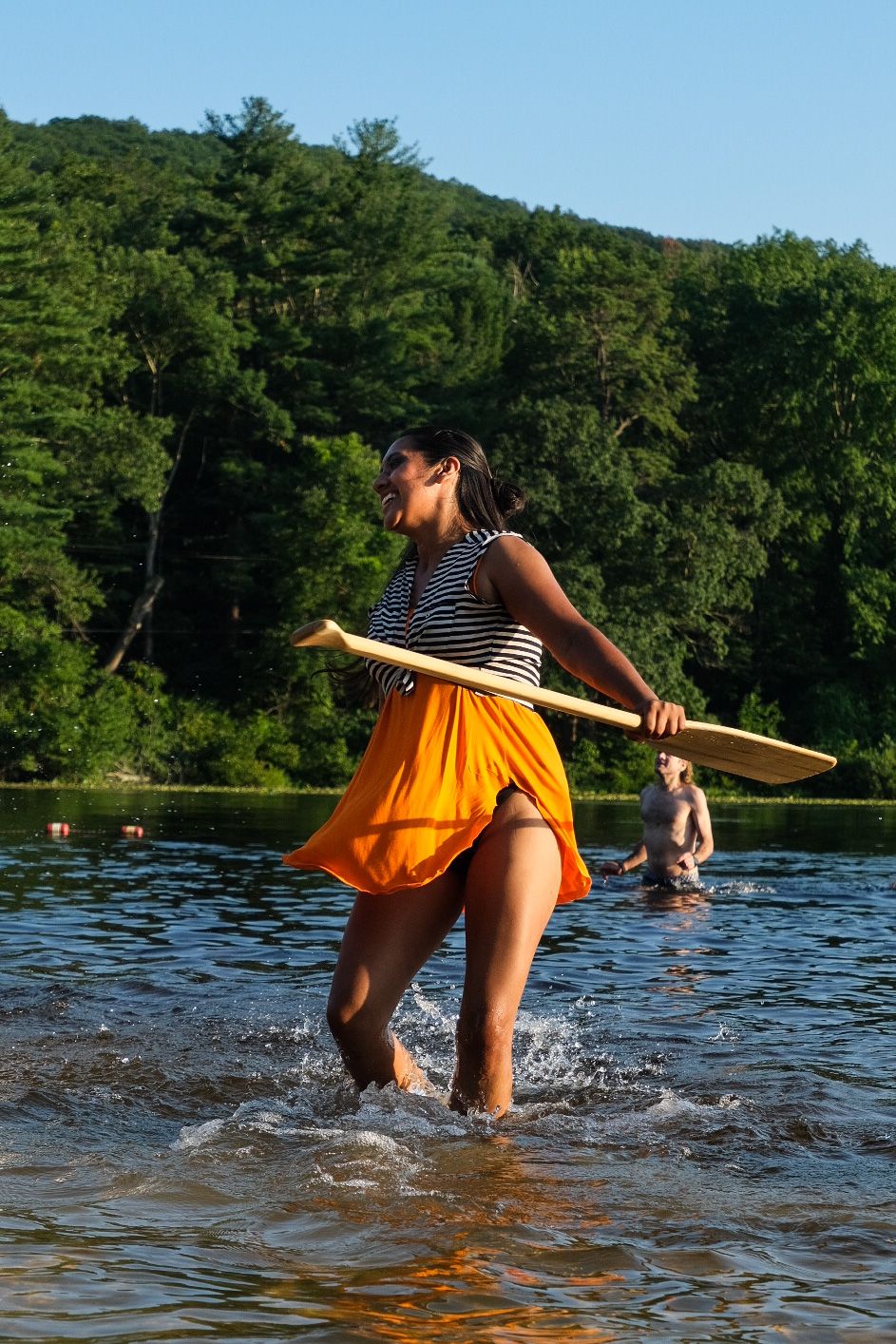
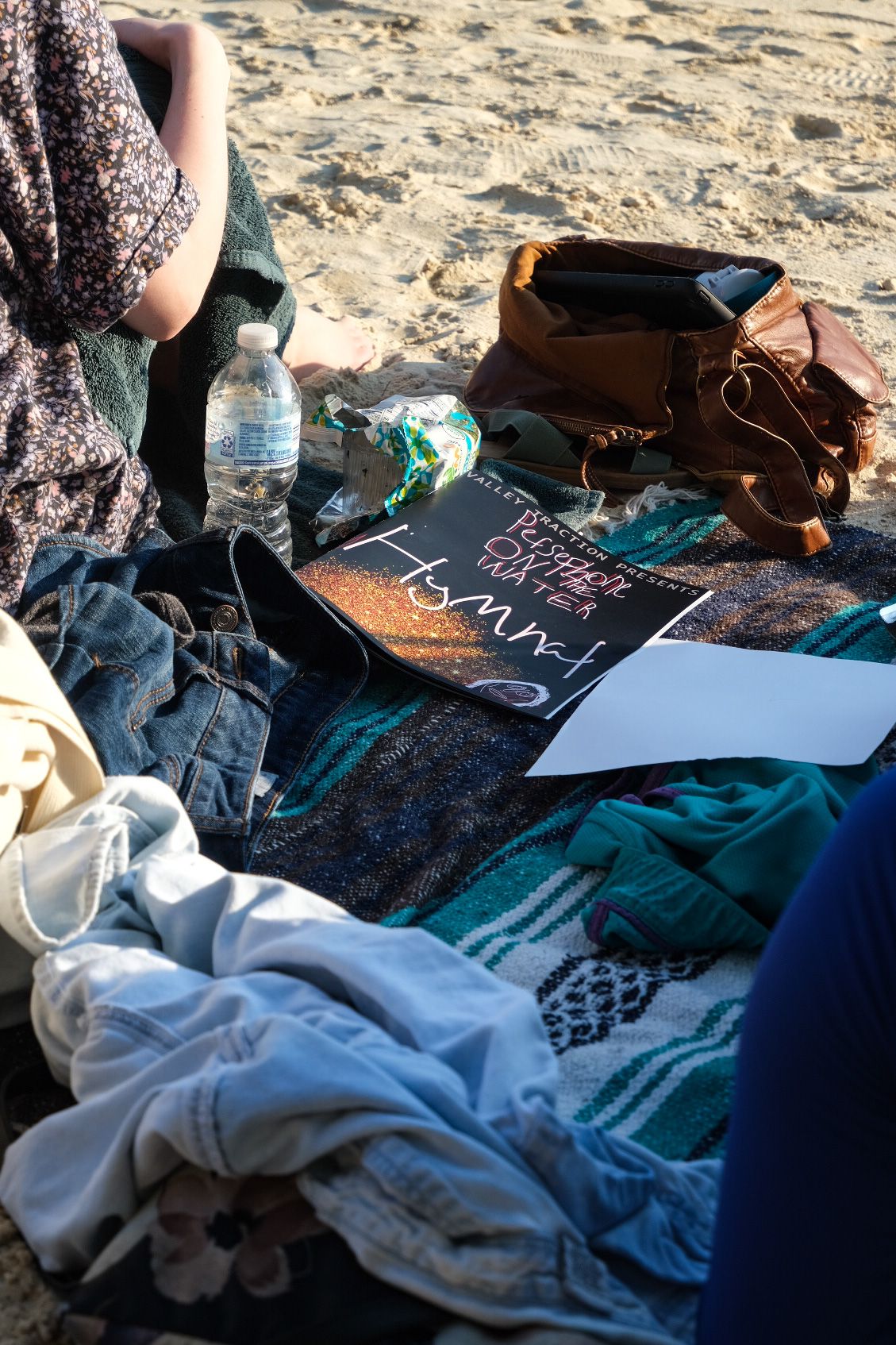

For Now My Companions
2022Mo Geiger with Danielle Moser
Additional Contributions by Matt Steiman and Harmony Esqueda
Based on a spiral-bound book originally made for field notes, this weatherproof, portable publication documents 2 years of sheep-related research and art projects made in collaboration with Danielle Moser. As a living history, it is contained within a project called SheepKit: a Fluxus-style box of narratives, prompts, and learning tools that is now housed with the other livestock tools at the Dickinson College Farm. This printed publication was supported by the Cumberland County Historical Society and served as Mo’s graduate publication in the Art and Social Practice Program at Portland State University.
Conversations on Everything
2020-22(individual text links below)
A triannual edition of SoFA Journal that compiles a series of interviews in each issue, published by the Portland State University Art and Social Practice program.
Seeds! with Dr. Jennifer Kling (Spring 2022)
It’s Hard to Imagine Myself as a Curator, with Abigail DeVille (Winter 2022)
Living Language, with William Padilla-Brown (Fall 2021)
Strip Mall Hustle and the Other Violin, with the Target Family (Spring 2021)
On the Other Side of the Fence, with Danielle Moser (Winter 2021)
Considering Utility, with Mary Mattingly (Fall 2020)
AssemblyTV Guide
2021Schedule and event guide for AssemblyTV: which appeared in 2021 as a week-long version of the Portland State Art and Social Practice program’s annual social practice conference called Assembly. The layouts were inspired by old TV Guides and sharpie zines. In a time of constant pandemic exhaustion, this printed and digital guide was an attempt to feel more connected by using the things we already had available, combined with levity and a quick+dirty aesthetic.
Co-conceived and designed with Laura Glazer and Diana Marcela Cuartas
Cover Illustrations by Shelbie Loomis
Event Ads designed by each student who presented
Planning organized by Becca Kauffman

Needle and Thread
2020Instructional zine designed and drawn to be a teaching tool for ART 216: Sewn Construction at Portland State University (during remote learning of Spring 2021)
Class instructor and zine maker: Mo Geiger
